Lynton and Lynmouth Cliff Railway
TODAY'S ITINERARY
Exploration: Tuesday, 19 June, 2019
lv London Paddington 0635 Great Western Railway
ar Exeter St Davids 0841
lv Exeter St Davids 0927 Great Western Railway
ar Barnstaple 1033
lv Barnstaple bus station 1120 Filers Bus
ar Lynton Granville Garage stop 1215
lv Lynton The Studio stop 1645 Filers Bus
ar Barnstaple bus station 1740
lv Barnstaple 1814 Great Western Railway
ar Exeter St Davids 1932
lv Exeter St Davids 1955 Great Western Railway
ar London Paddington 2237
I knew this day would be a long one. It seemed best to me to do the longest journey first and not later on when I was tired from my travels. I left the hotel at 0530 and returned at 2300. On the up side, this was the best one. If you see only one funicular and you are are insane, check the current timetables and copy this. Or stay in a hotel in Exeter: that would make more sense really.[note 1]
There's something exciting about going into Paddington early in the morning from the Underground station. The crisp night air, the walk under the vast iron and glass trainshed, 165 years old, and the somehow appropriate sight within of modern trains and the electronic departure boards on "the lawn", the space across the ends of the tracks. I've been here a few times now and the feeling never fails me.
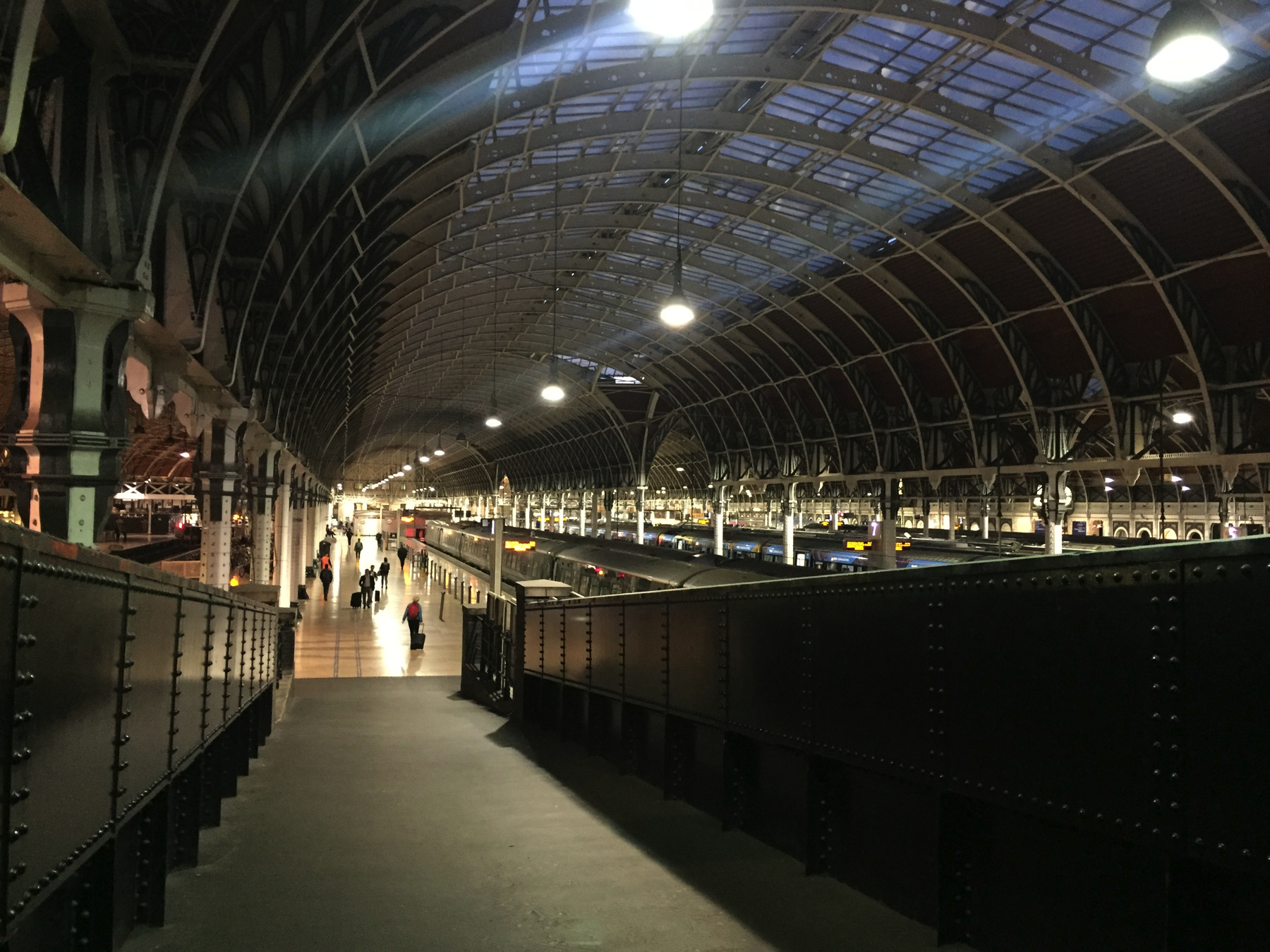
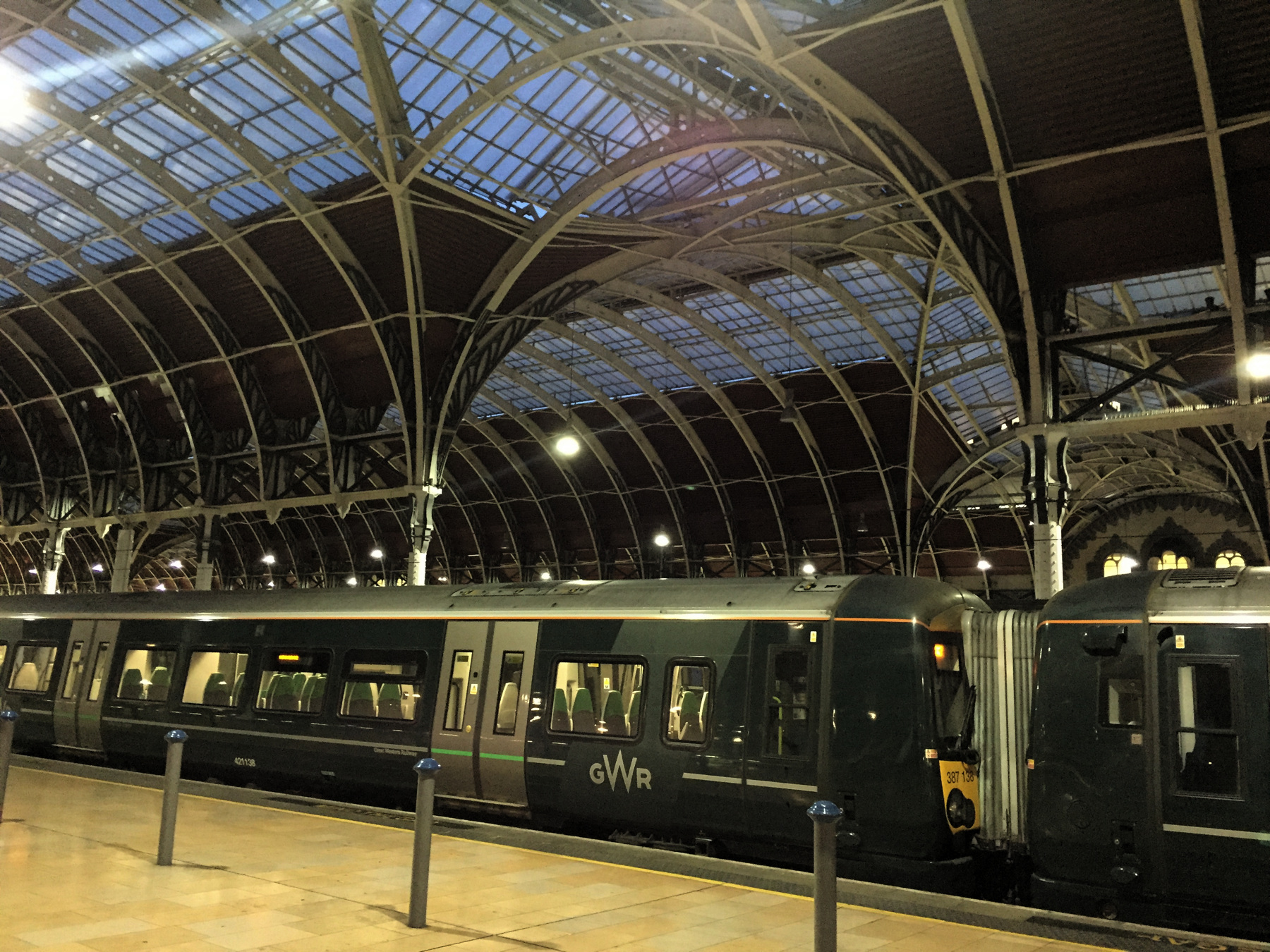
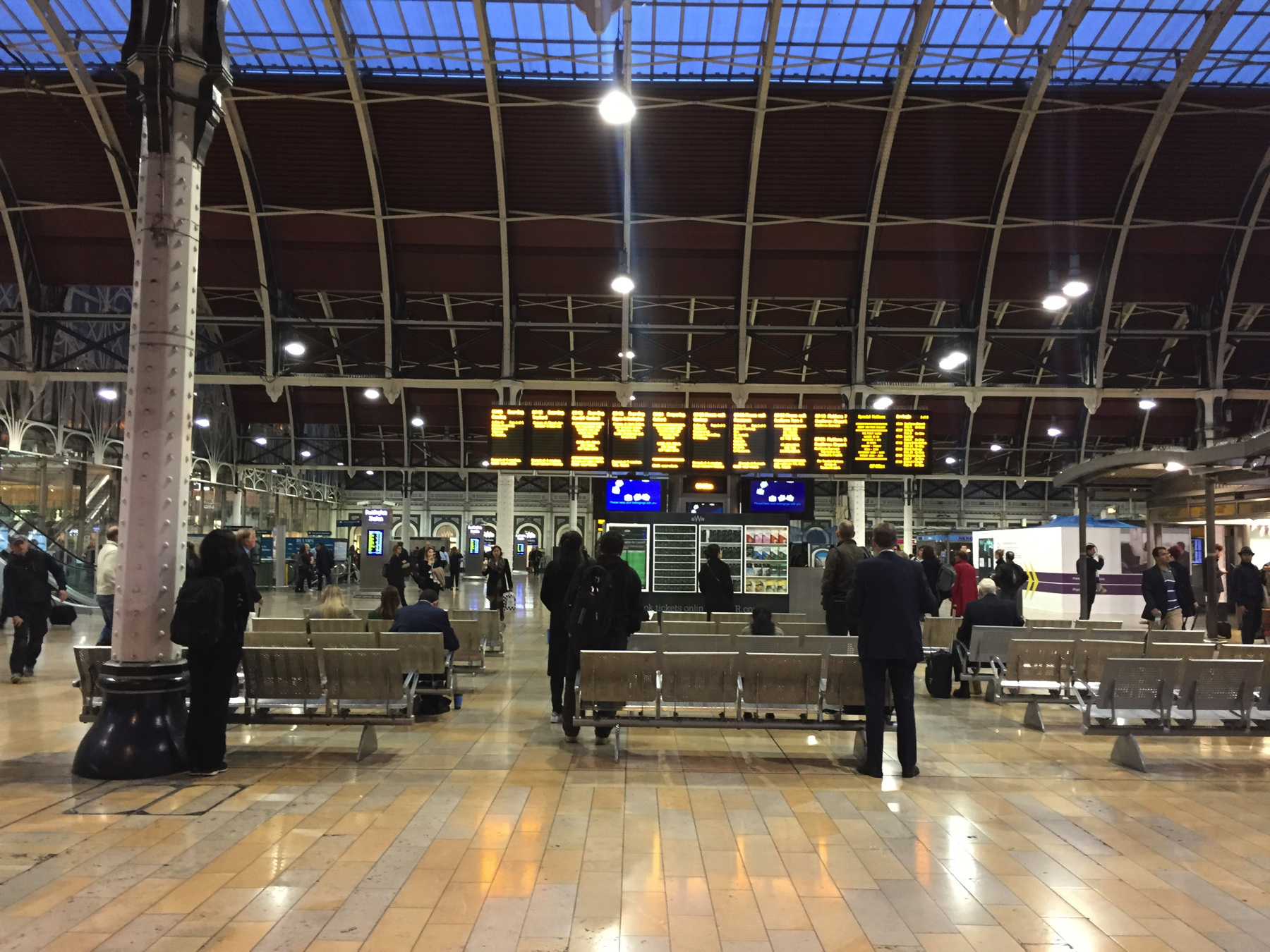
That's "The Lawn" above, the tracks out of view to the right. Eleven monitors show the next eleven departures and all of the stops each train will make. I knew which train I wanted but it was reassuring to see my destination listed there. From a stand on the lawn I secured a pair of excellent croissants and a small Americano—I do feel awkward requesting an Americano coffee in my foreigner's voice, even when I think the Euro clerk can't catch the accent—but it's the good coffee. After waiting a bit for the track to be shown I boarded an empty coach of the 0635 Great Western train to Penzance and dropped down the tray table at my seat and enjoyed breakfast.
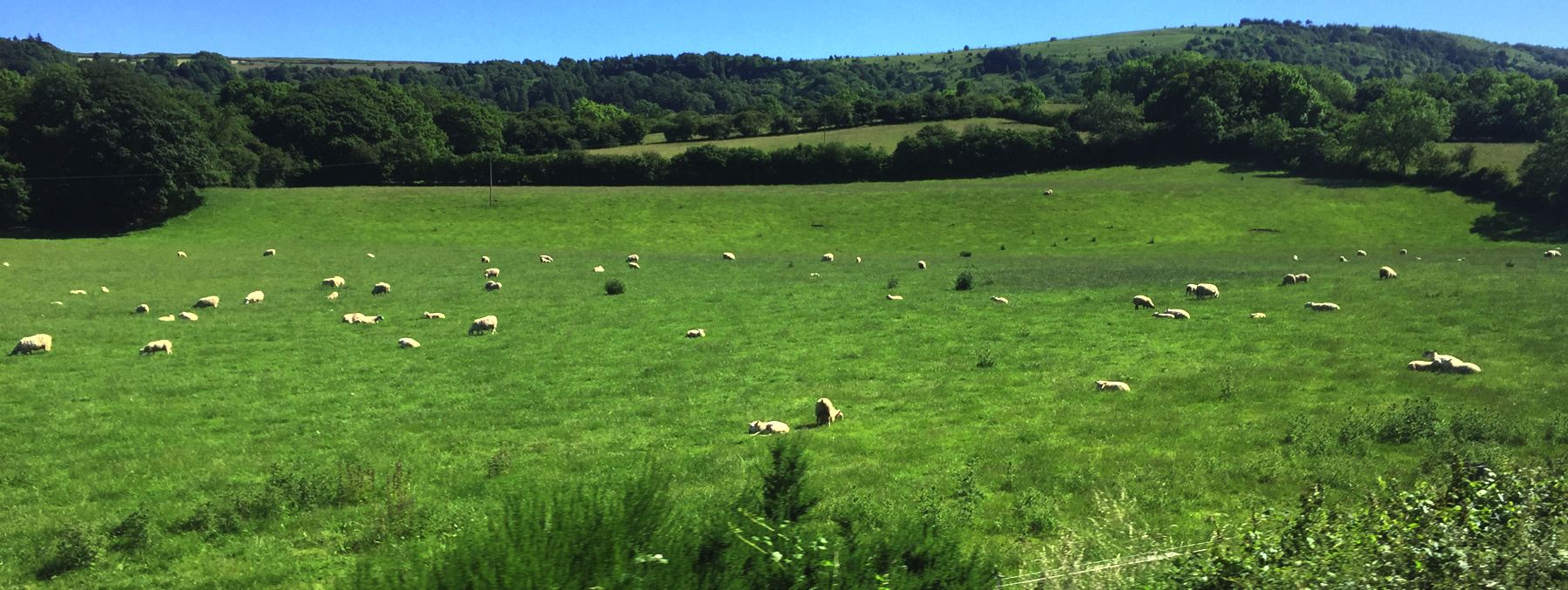
The National Sheep Association puts the sheep population of the United Kingdom at 33 million. I saw many of them.
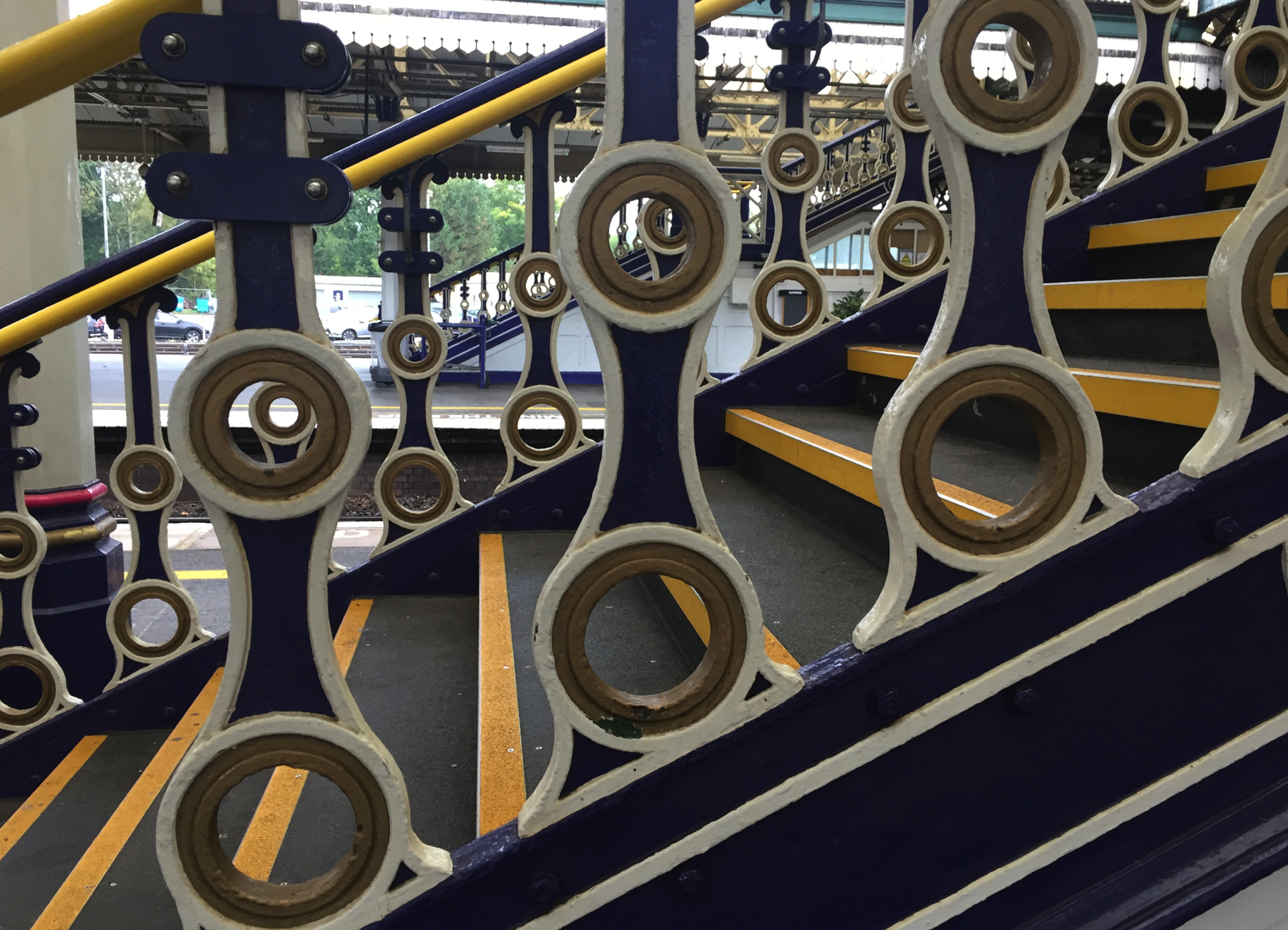
As you can see in the itinerary I had to kill the better part of an hour at Exeter St Davids. National Rail scheduling is usually very good—it is rare (at least in my experience) to wait more than fifteen minutes for a connection—but evidently they don't expect anyone to come in from London and go on to Barnstaple.
St Davids is nearly a mile from the middle of Exeter, but still it is not the worst place to wait. After I admired the painted ironwork of the stairways (above) I walked outside to stretch my legs with a circuit around the station approach and recalled old times [note 1]. And then I ambled into the station's roomy Starbucks for breakfast number 2. No hurry. I know, I know. All this way and I'm having food at Starbucks which I could do a mile from home in either direction. It was there, all right?
The Tarka Line to Barnstaple is single track except for two stations with double track where trains can pass, Crediton and Eggeston. After a crossover switch beyond Crediton the railway appeared to remain double track but in fact the second track was the Okehampton Branch, so it was effectively two parallel single track railways until the place where the branch curved off.
We went almost entirely through beautiful farm country with small settlements near the stations. Exceptions are a new residential development at Copplestone and another near but not quite at Lapford, and of course the only large old town on the branch, the ultimate destination, Barnstaple. Many of the other places, like Kings Nympton (what is that?), are request stops. For those keeping score, our train was a 150/2 class Sprinter built in the mid 1980s, a two-car set with diesel motors.
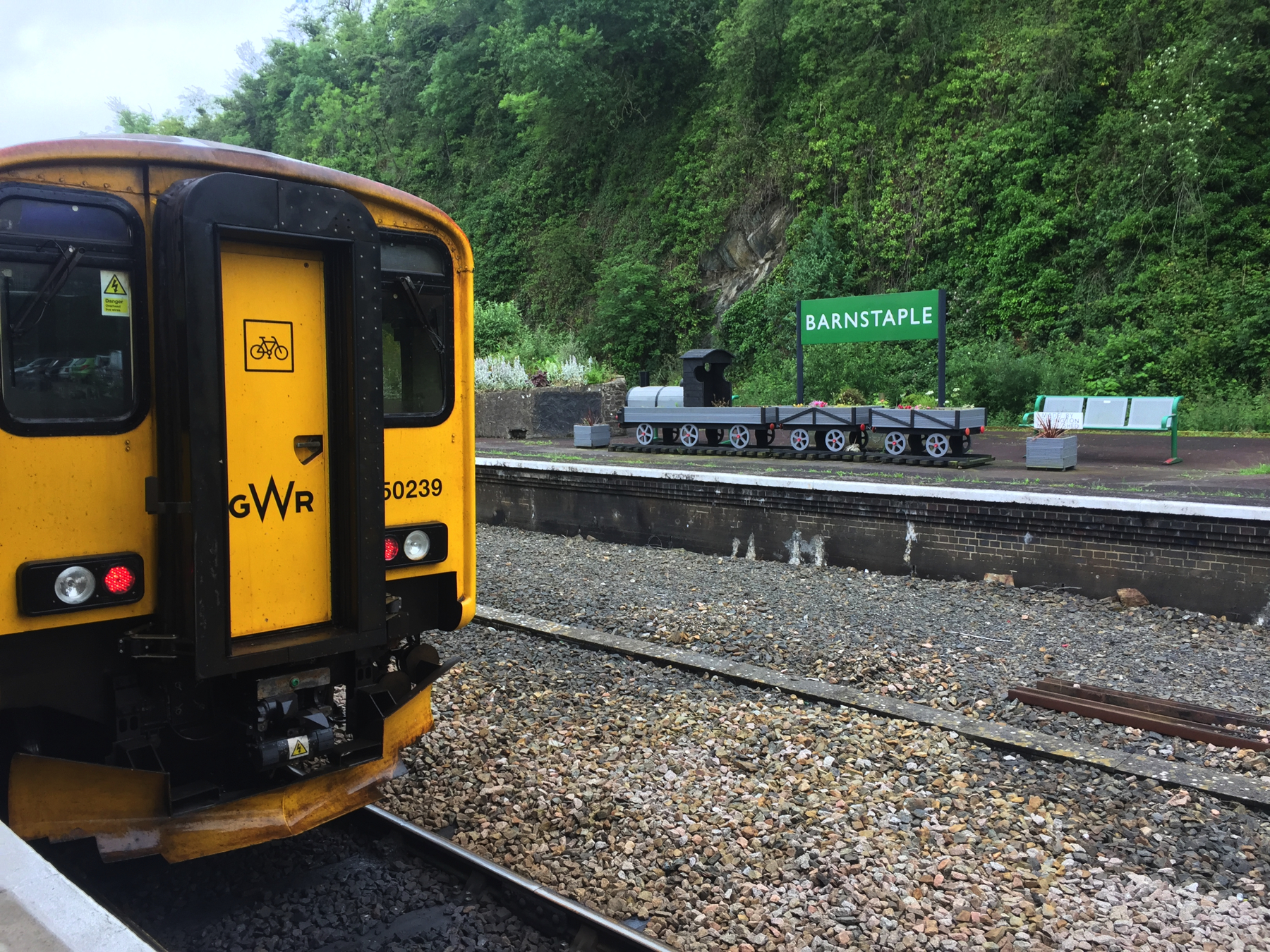
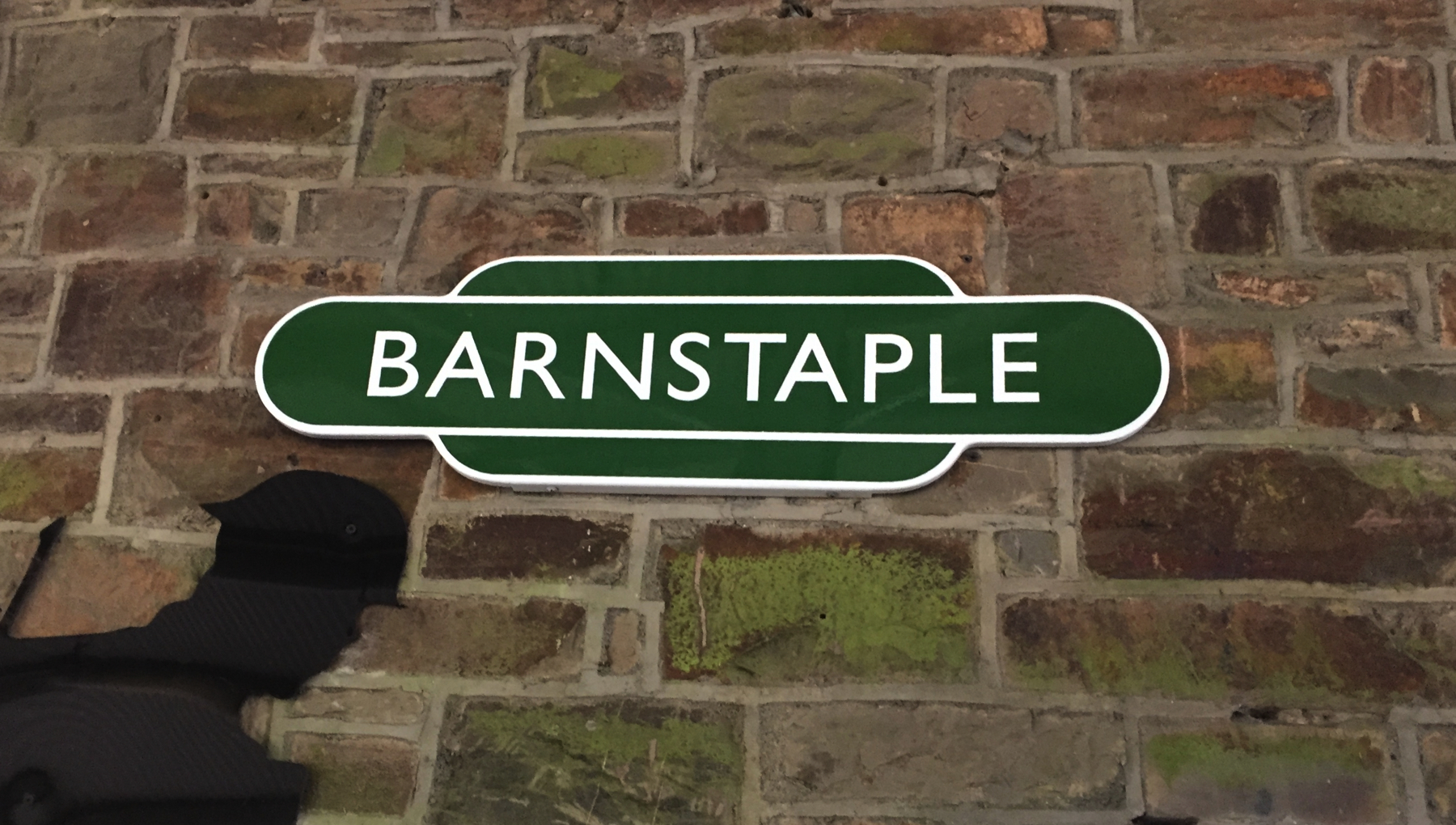
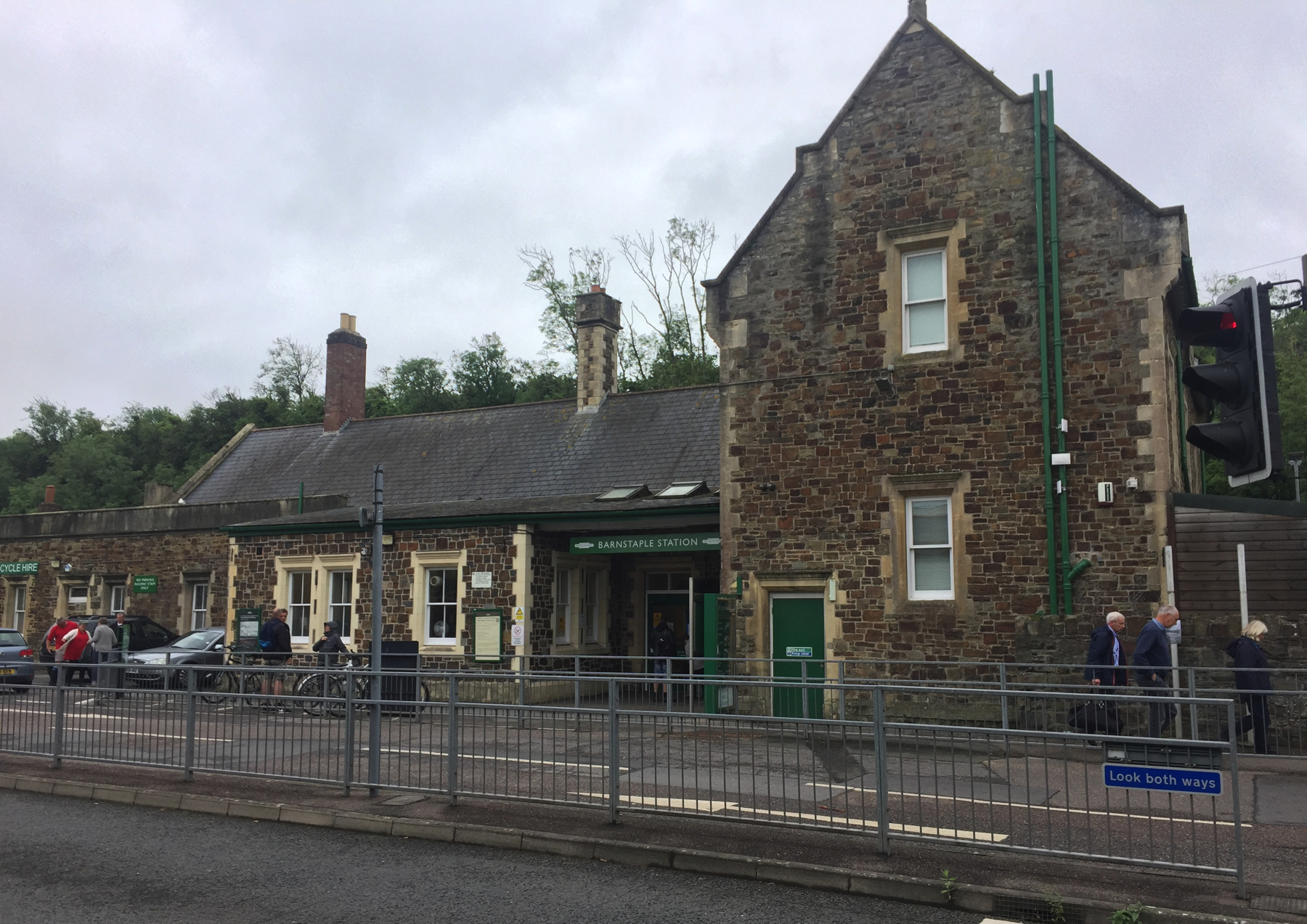
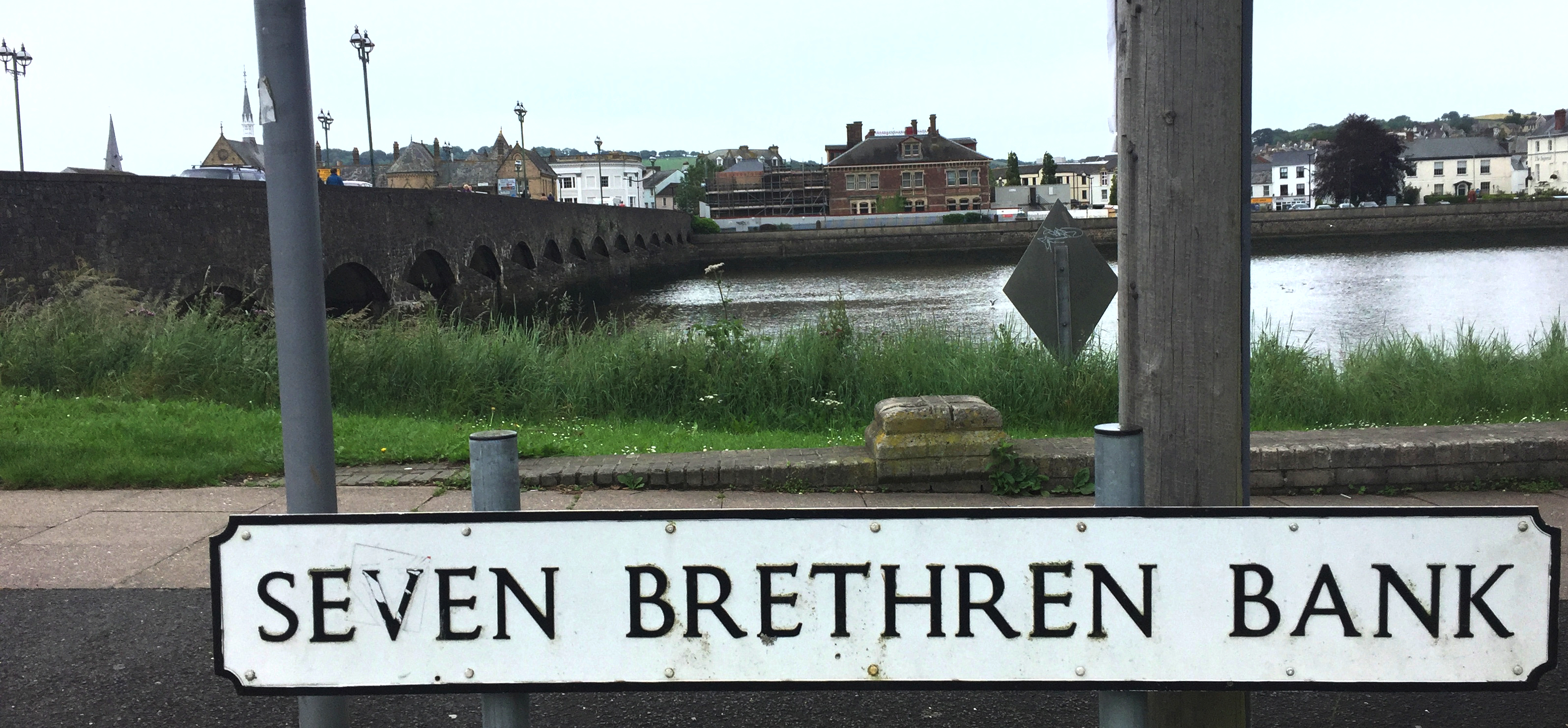
Barnstaple. Pronounced Barnstibble. The railway stops short of the town itself, which is across the River Taw. The station was once called Barnstaple Junction, because from here one branch crossed the river to Barnstaple Town station, by a bridge just west of the road bridge, and another continued on this side along the coast. I suppose the idea of cutting it back where they did was to avoid maintaining the bridge. The bus terminal by contrast is more logically located over there in the town, so I walked across the bridge. Barnstaple has its old buildings to gawk at, and even a museum with the elephant fossils that had been dug up somewhere in town. British elephants! But sadly I had no time to spare.
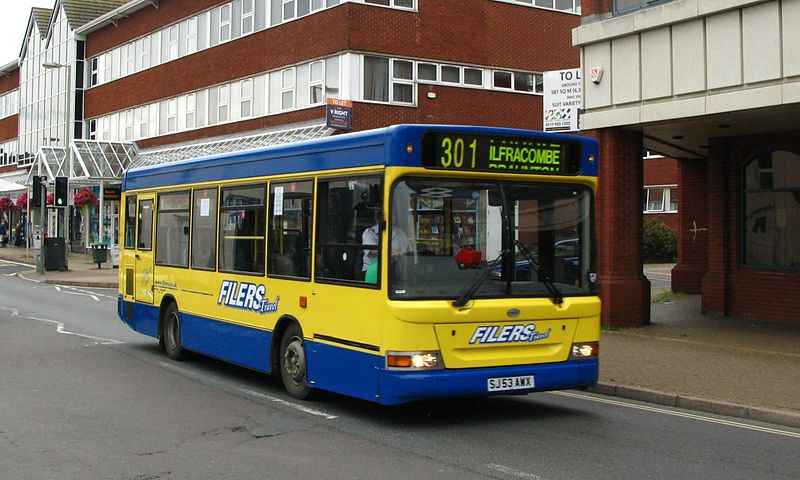
(above) Photo by Geof Sheppard.
This file is licensed under the
Creative Commons
Attribution-Share Alike 4.0 International license.
The last stage of my journey was by Filers Bus. I'm not a big bus fan but this was a great ride. I neglected to take a photograph of the bus but a Wikipedia contributor grabbed a shot of the same kind of bus in Barnstaple.
The driver was about as old as I am. As I boarded I asked him the big question on my mind: is Lynton called "linn ton" or "line ton"? He smiled and told me the former. Good. I then asked the other important question: how much is a return ticket? Five pounds was totally reasonable. The floor rises toward the back. I took a seat there where I'd have a good view out front.
The two-lane roads to Lynton are barely wide enough for cars to pass, and here we were flying along on a full-width bus. Up and down, around turns. A few trucks came the other way. We negotiated a couple of villages where one of the two lanes was blocked by parked cars. When I left at Lynton I said to the driver, "I don't know how you drive a bus on roads like this," and he smiled again and said, "practice."
Now this story has come a long way and you still haven't seen pictures of a funicular railway. You know what? For me it was SIX HOURS to Lynton, and I wanted to make you feel it. It didn't take you six hours to read this far, did it? But here we are.
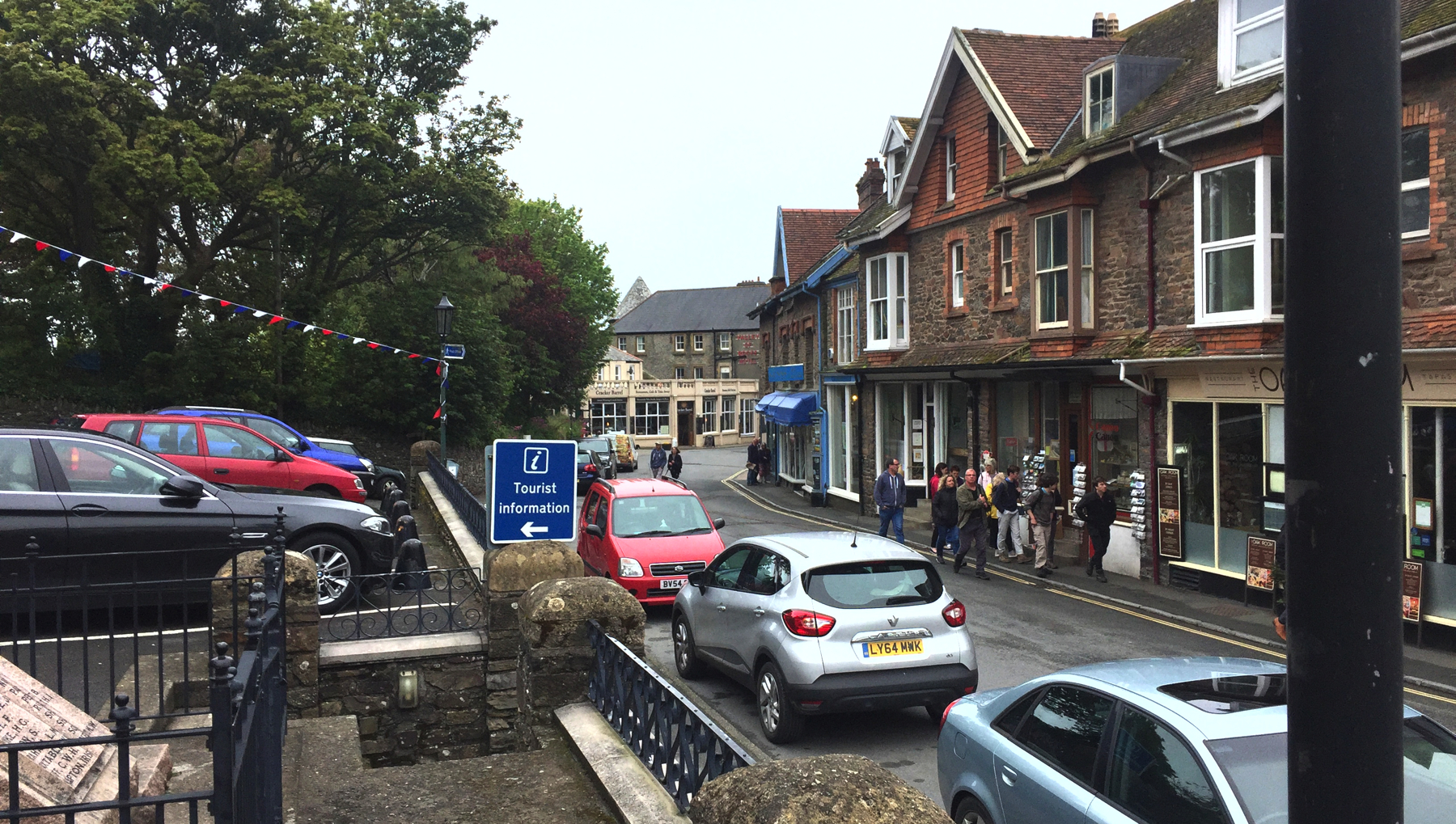
There! If you are scoring a town for quaintness, I think Lynton is near the top of the scale. We walk down Lee Road, and yes this is a two way street and the bus runs along it. We pass the town hall and tourist information, and up ahead just before the Cracker Barrel is the lane leading to... the Lynton & Lynmouth Cliff Railway!
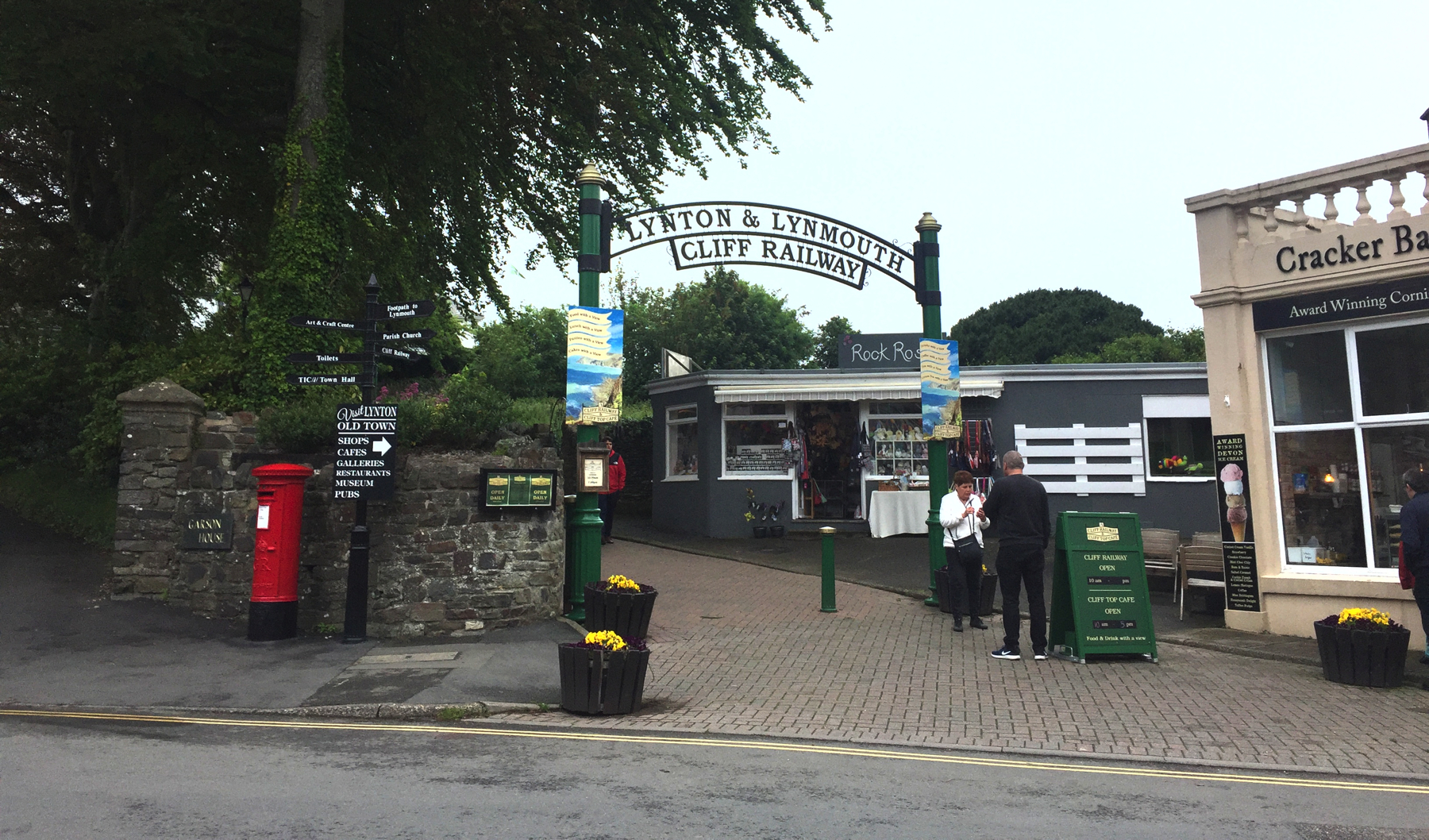
I could have gone straight in then and there, but life has taught me that sometimes it can be better to take time and fully enjoy an experience and not be all done with it too fast. An unusual feature of this cliff railway is that there are three bridges over it. Why not walk partway down first and get a good look from those bridges at what I was about to experience?
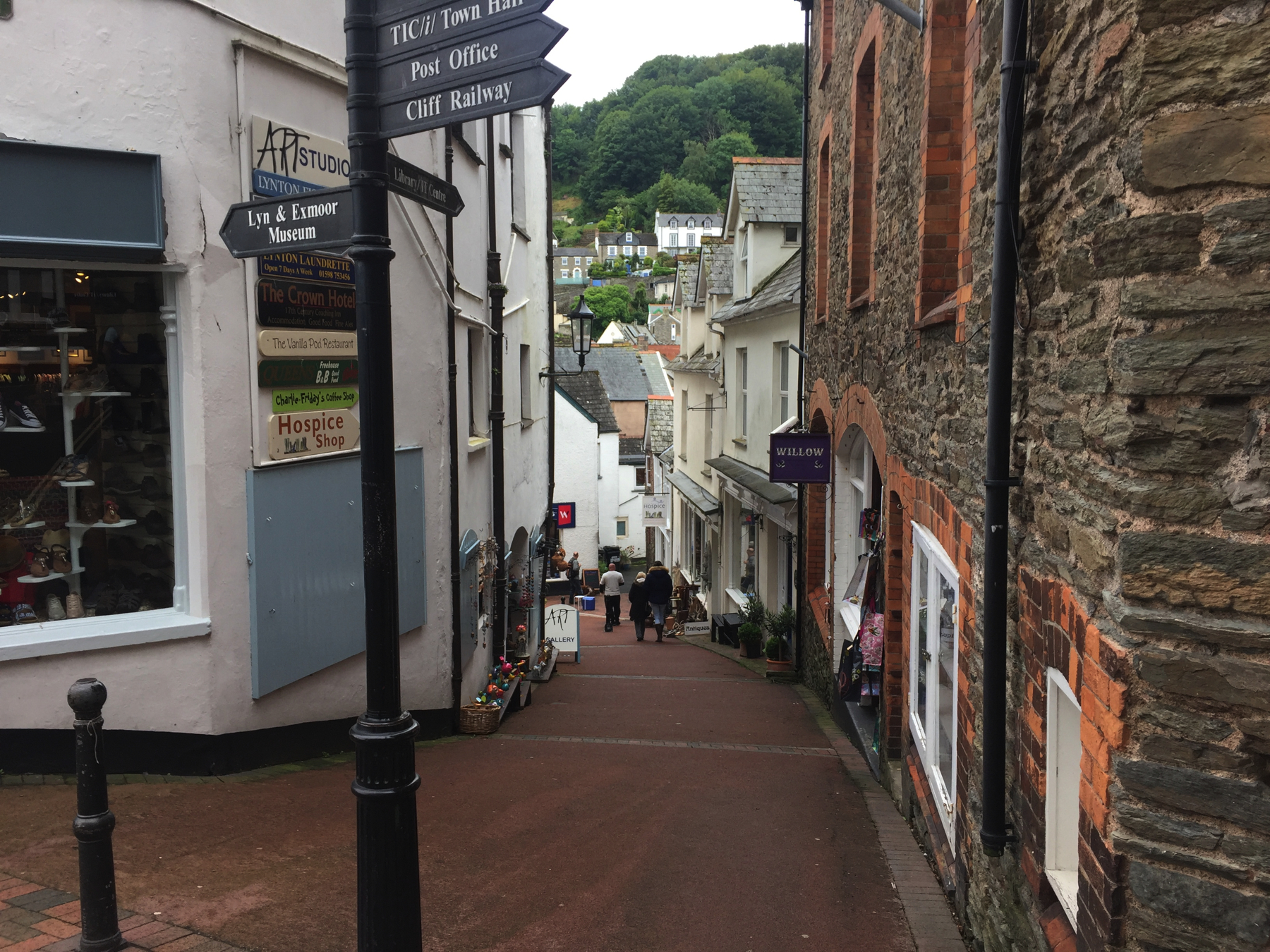
A glance to the right from the same spot on Lee Road shows how hilly Lynton is on the side away from the cliff lift.
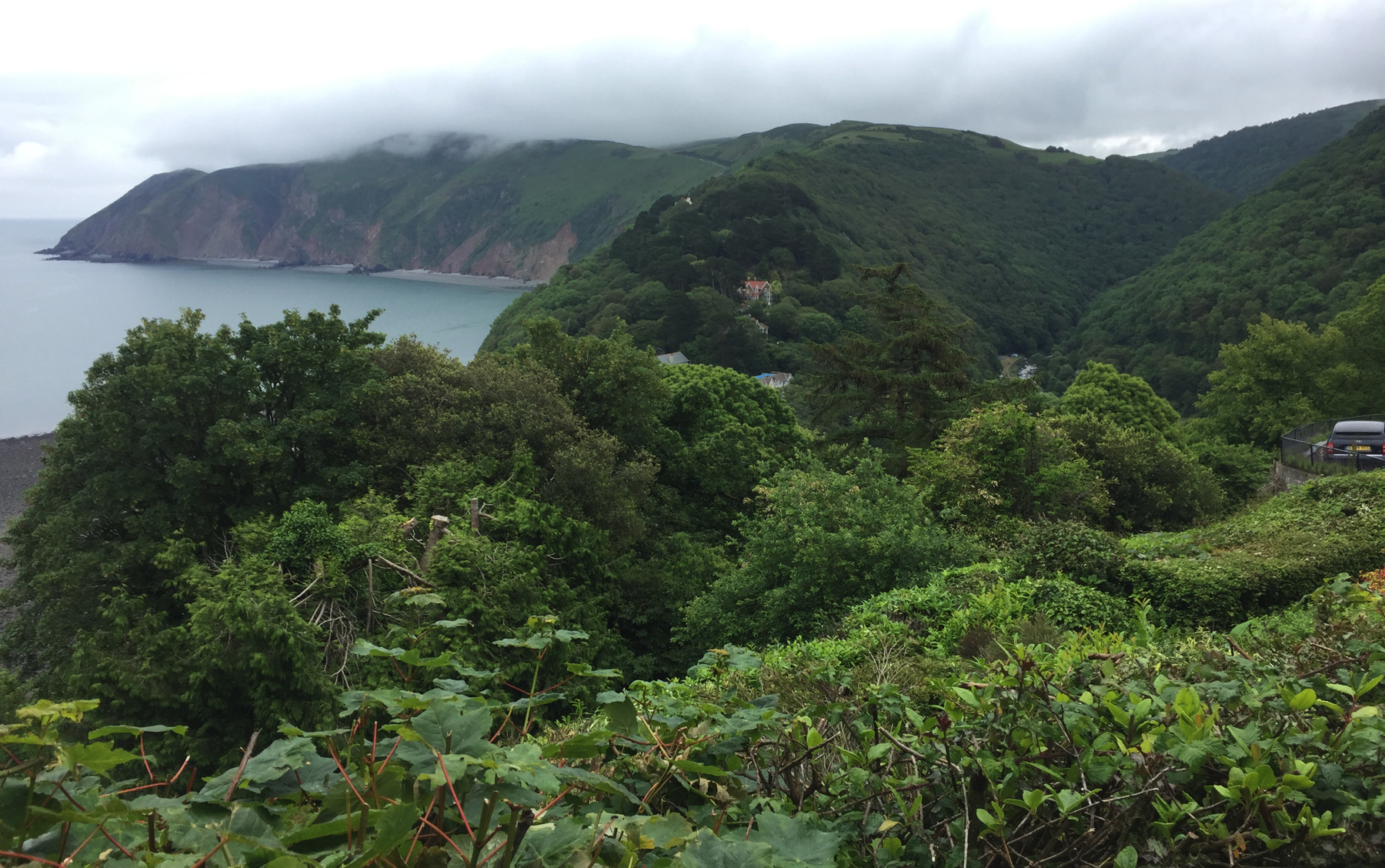
And this view to the north, from just a short way down the zig zag, shows the terrain even better. Lynton is about 500 feet above sea level, and its partner Lynmouth is hidden down there behind the trees. At right center that's a little peek at the River Lyn. This is beautiful country.
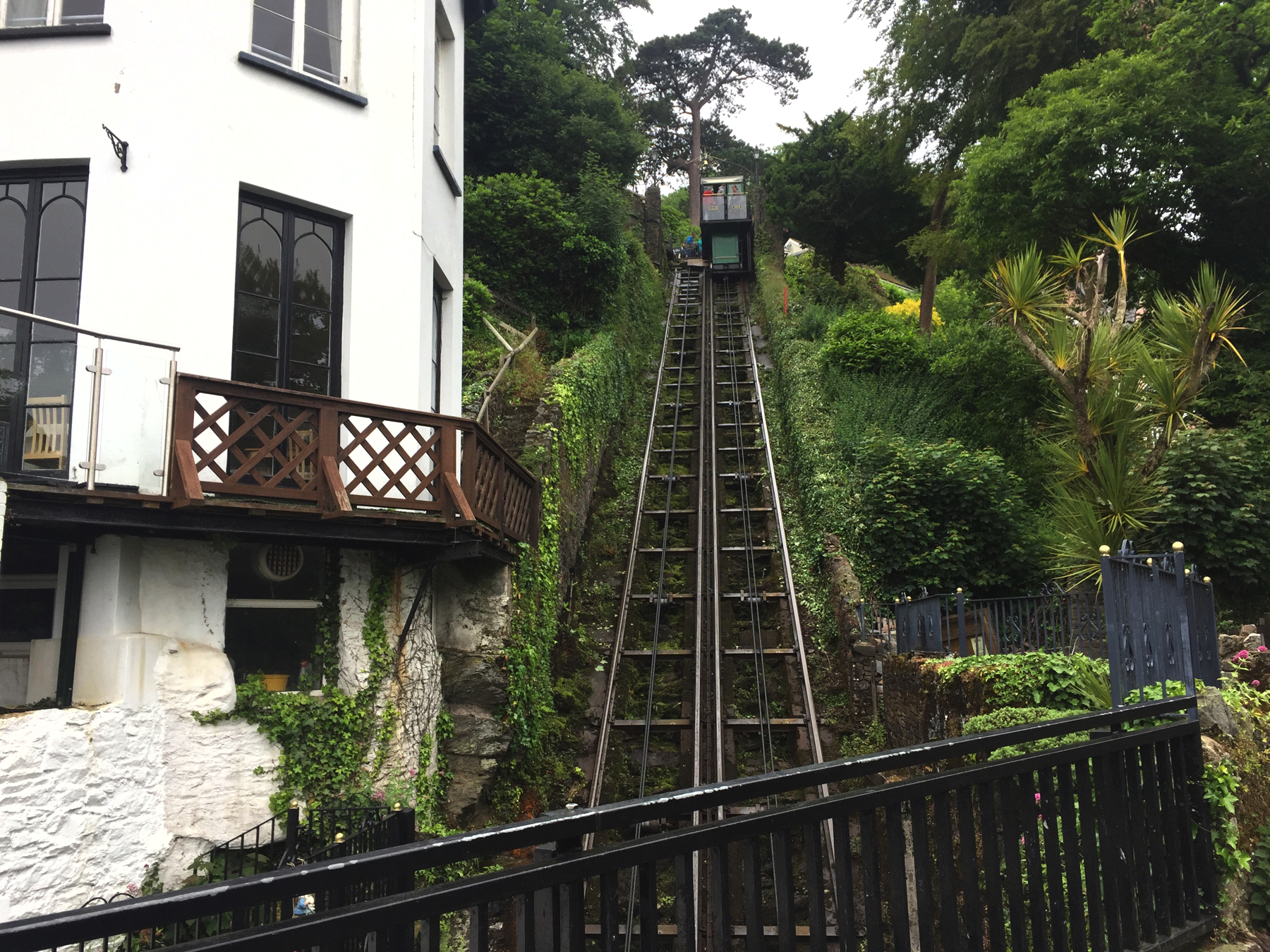
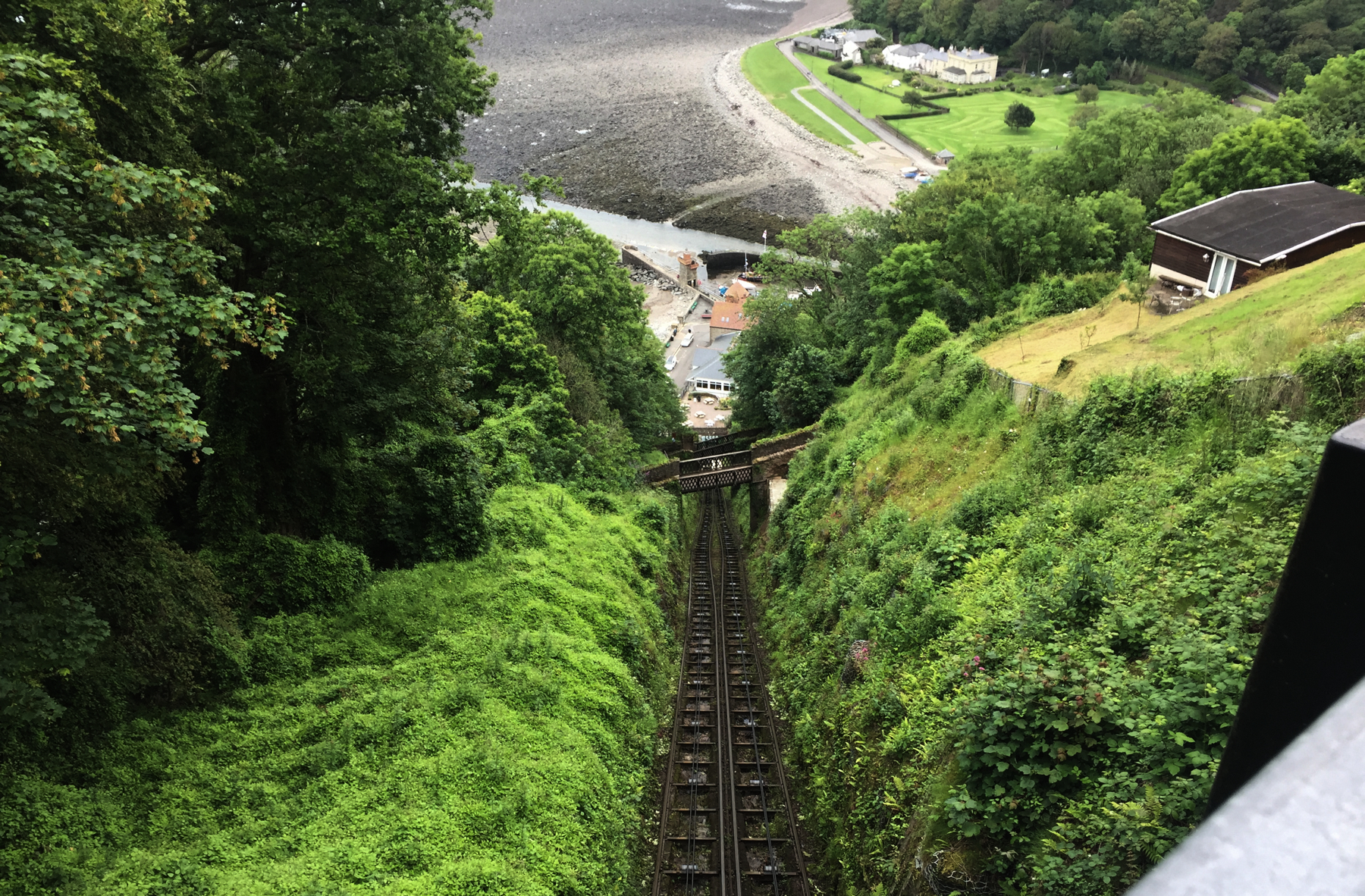
At last... here is the cliff railway, above and below the first bridge. Some of Lynmouth is visible down there, and the River Lyn where it is about to enter the sea.
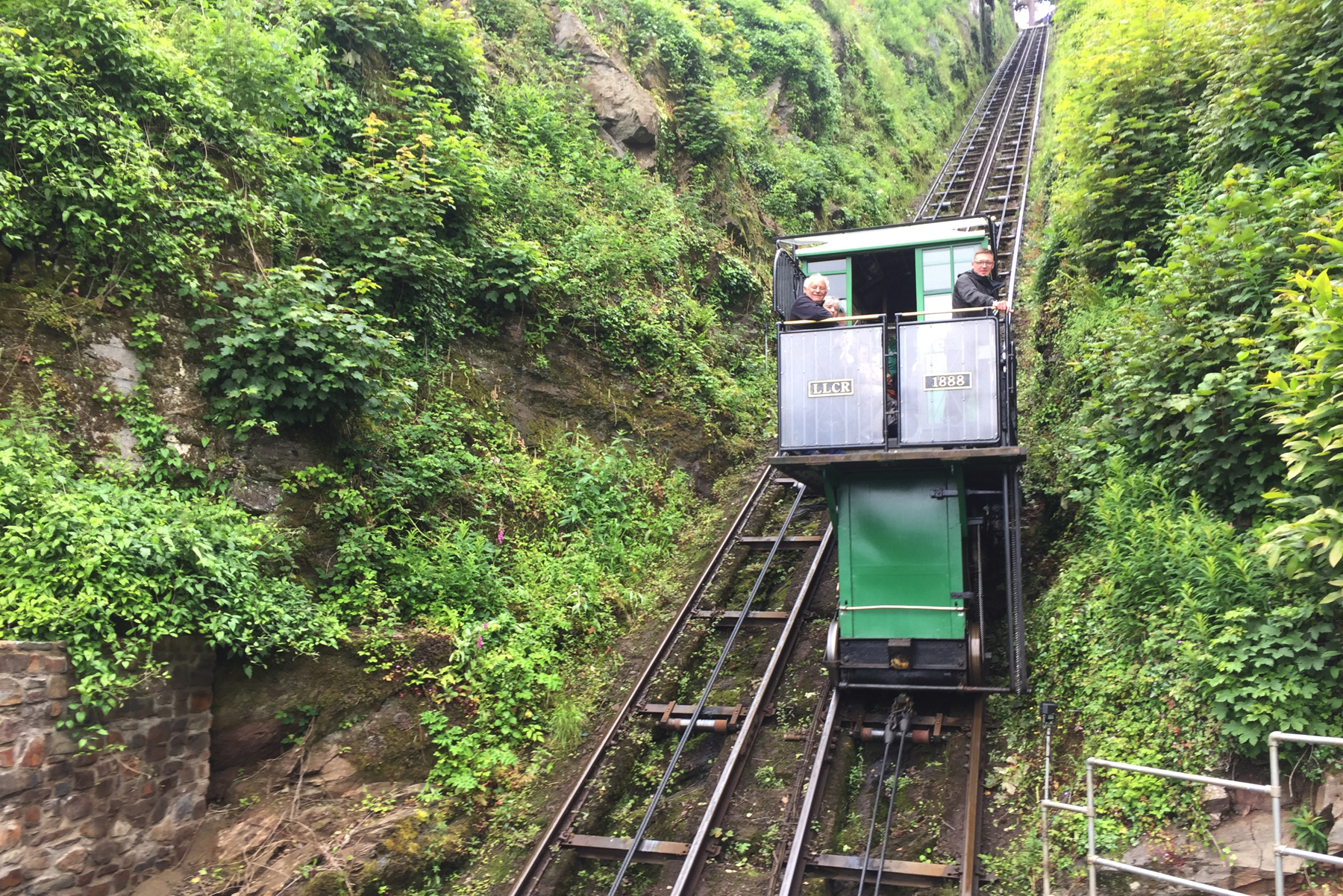
A good view of a car from the second bridge. The green container under the floor is the water tank, and this one is empty since the car is going up.
This cliff railway is water balanced. It works completely by gravity with no motors or engines involved. As usual a cable runs from the upper end of each car around a pulley at top. For safety it's a pair of cables on many funiculars, as you see here. When the car at the top has a full water tank, and the car at the bottom has an empty tank, and the brakes are released, heavier top car goes down and pulls the other one up.
In this picture, the car with the full tank is out of sight below this point on the left side track. Its weight is pulling up the other car that we see here.
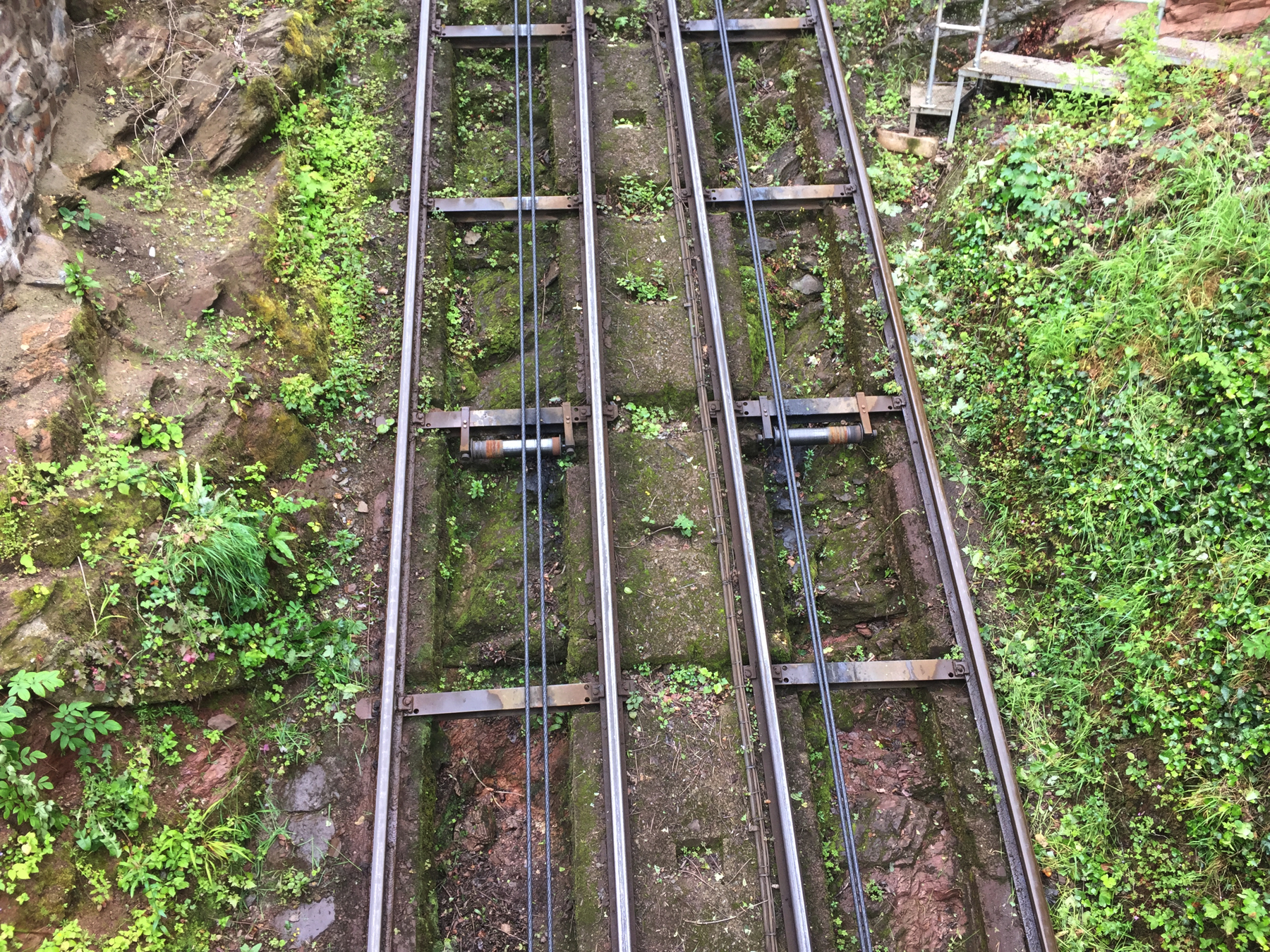
The tracks, from the same position.The rails rest on stone sleepers—a very old style of track. Gauge is maintained by the steel cross ties. Rollers are provided about every third cross tie to hold the cables.
I spent a few minutes watching the cars, and by the time I took this picture they had changed places. The car on the right hand track is now below us. I can tell because the cable that holds up the cars is tight together.
So what is the other cable for? It connects the lower ends of the cars, with a pulley wheel at the bottom of the cliff lift. It doesn't seem to do anything. We find the answer by remembering that this cliff lift is powered completely by gravity. I have to admit, I needed to be told about the reason for the other cable. It's one of those things that is obvious once you are told.
Consider the situation where one car is at the top and the other at the bottom. The cars weigh the same, so that's in balance. The one at the top has a full tank and the other has an empty tank, so the one at the top is heavier, right? Isn't that all we need?
No, we're forgetting something. There is something there besides the cars. The point of balance is at the pulley at the top. What do we have on each side? One side has a short length of cable and a car with water in the tank. The other side has eight hundred feet of steel cable and a car without water. Please note that steel cable is heavy. The weight of the cable matters! You need to balance the weight of the cable. Add another cable connecting the lower ends of the cars, and well then: on one side you have a car and eight hundred feet of cable, and on the other side, eight hundred feet of cable and a car. Now the cars and cable weight the same on each side, and the water in the tank is the difference! The lower cable is there to balance the other cable.
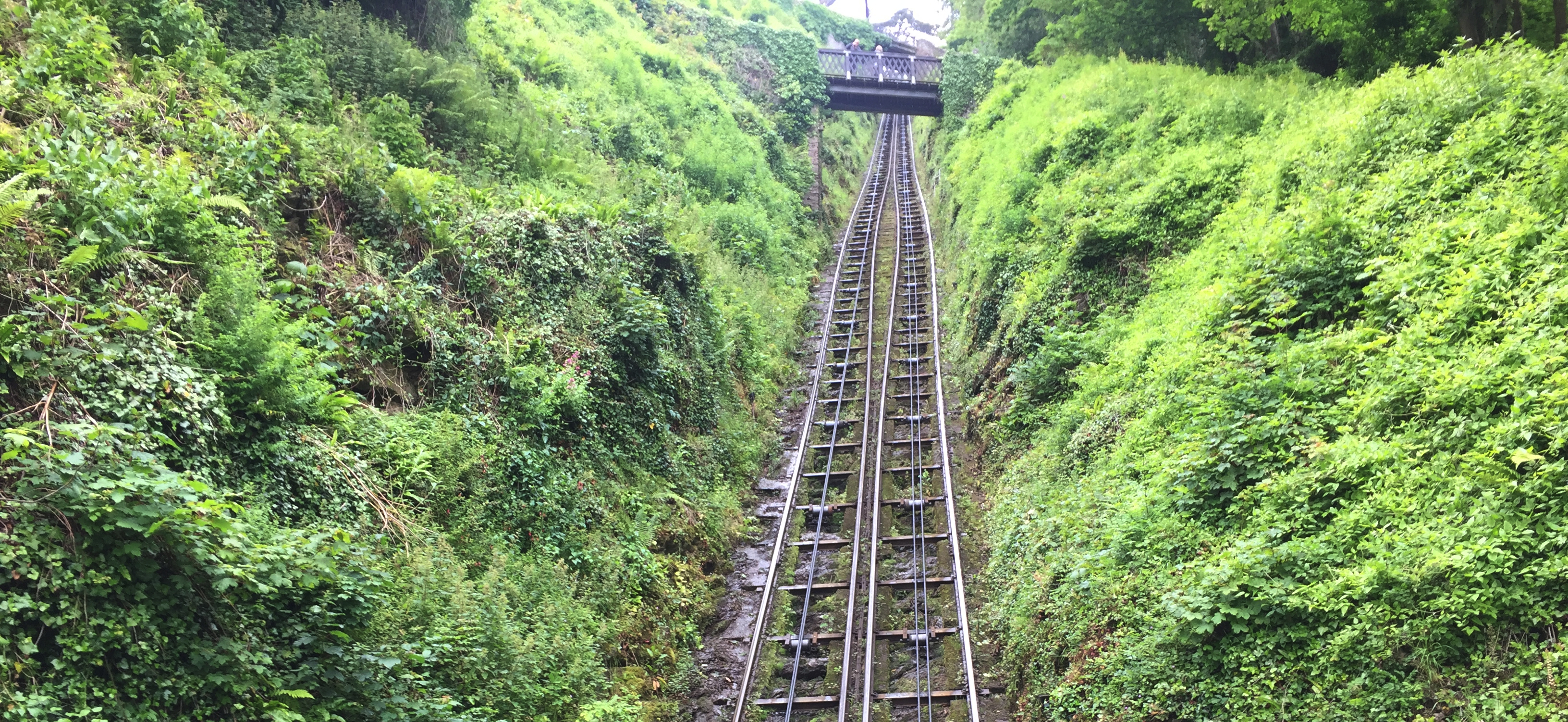
I went down to the third bridge, and up here is the view looking up to the second bridge. The spread of the tracks is at the halfway point where the cars pass.
The zig zag is very steep and I was starting to think about the climb back up. Of course I could have continued to the bottom and used the... cliff railway... to go up, but I wanted to enter the cliff railway through the somewhat grander entrance at the top, so back I went.
But I was hungry by now. Once I reached the top and walked down the lane to the cliff railway station, there was the Cliff Top Cafe. So I went in and I thought, this is Devon, I know what I have to ask for: a scone with clotted cream. I did, and of course they had it. I know that the name clotted cream sounds disgusting but the dairy product itself is not. It is wonderful. That is what I had. With Cafe Americano. Breakfast number 3.
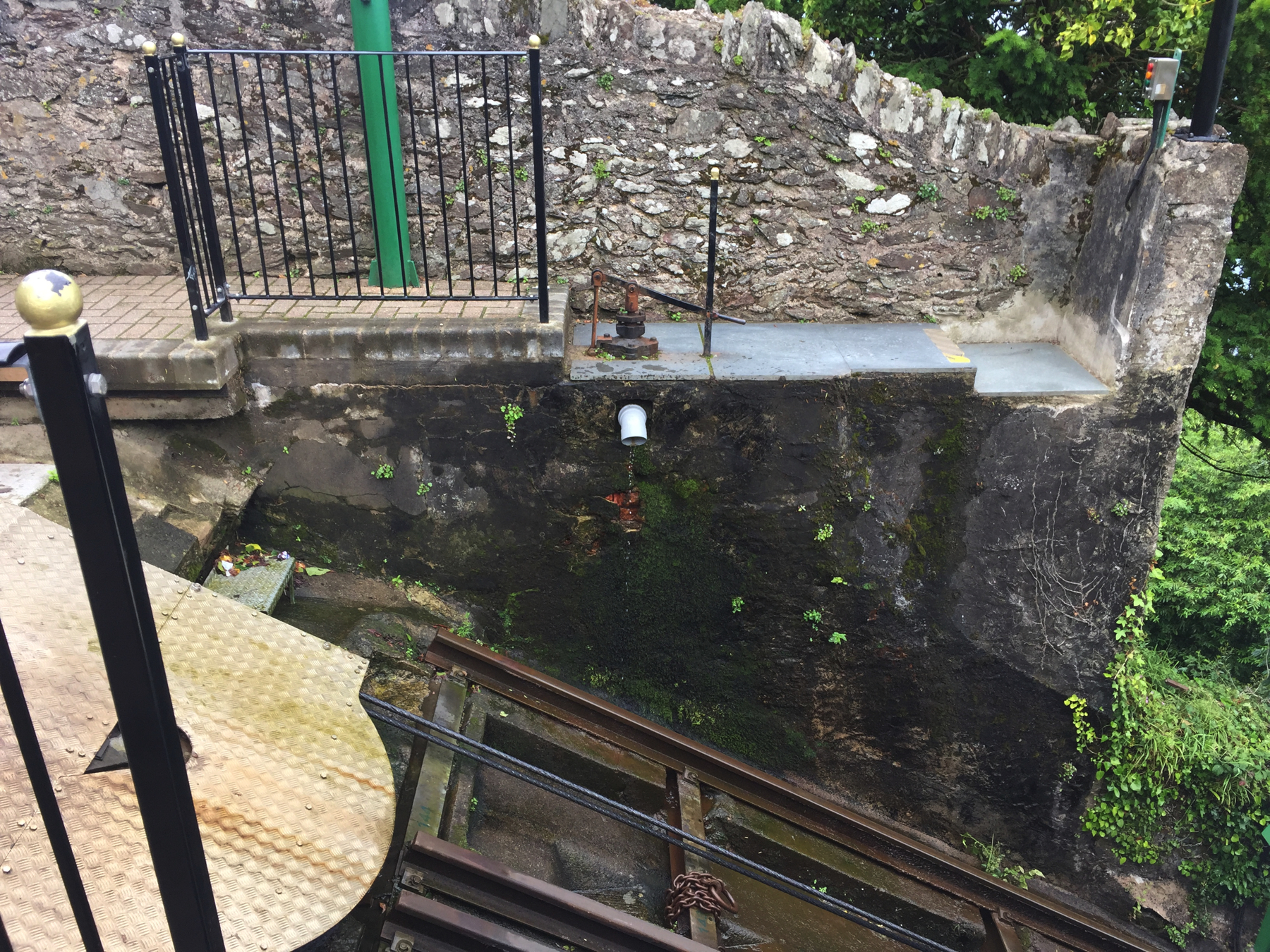
As seen from the Cliff Top Cafe: the hose dribbling water, next to the upper station. While people were boarding I asked one of the staff about how the water gets back to the top. The answer was that it doesn't. He told me the water comes from a river that is even higher up than Lynton, by a pipe about a mile long. It comes to the upper station by gravity, goes downhill in the cars, and it is dumped to the sea at the bottom. The river flows to the sea anyway, and so all they are doing is diverting some of its water to the sea through the cars. The cliff lift is completely powered by water and gravity, and it is the only one that is. There is no motor. It could not be greener. Since 1890 the river has never failed.
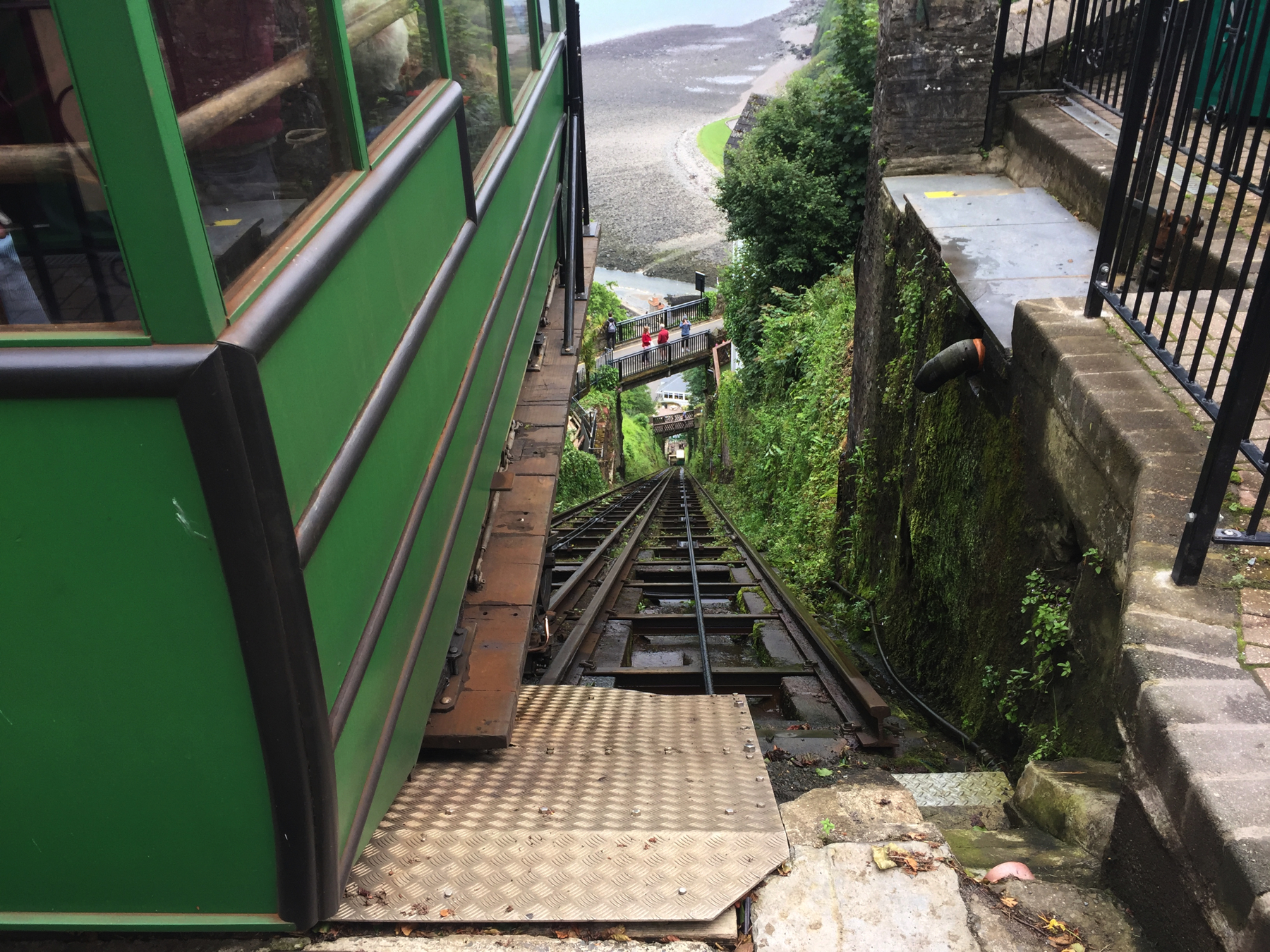
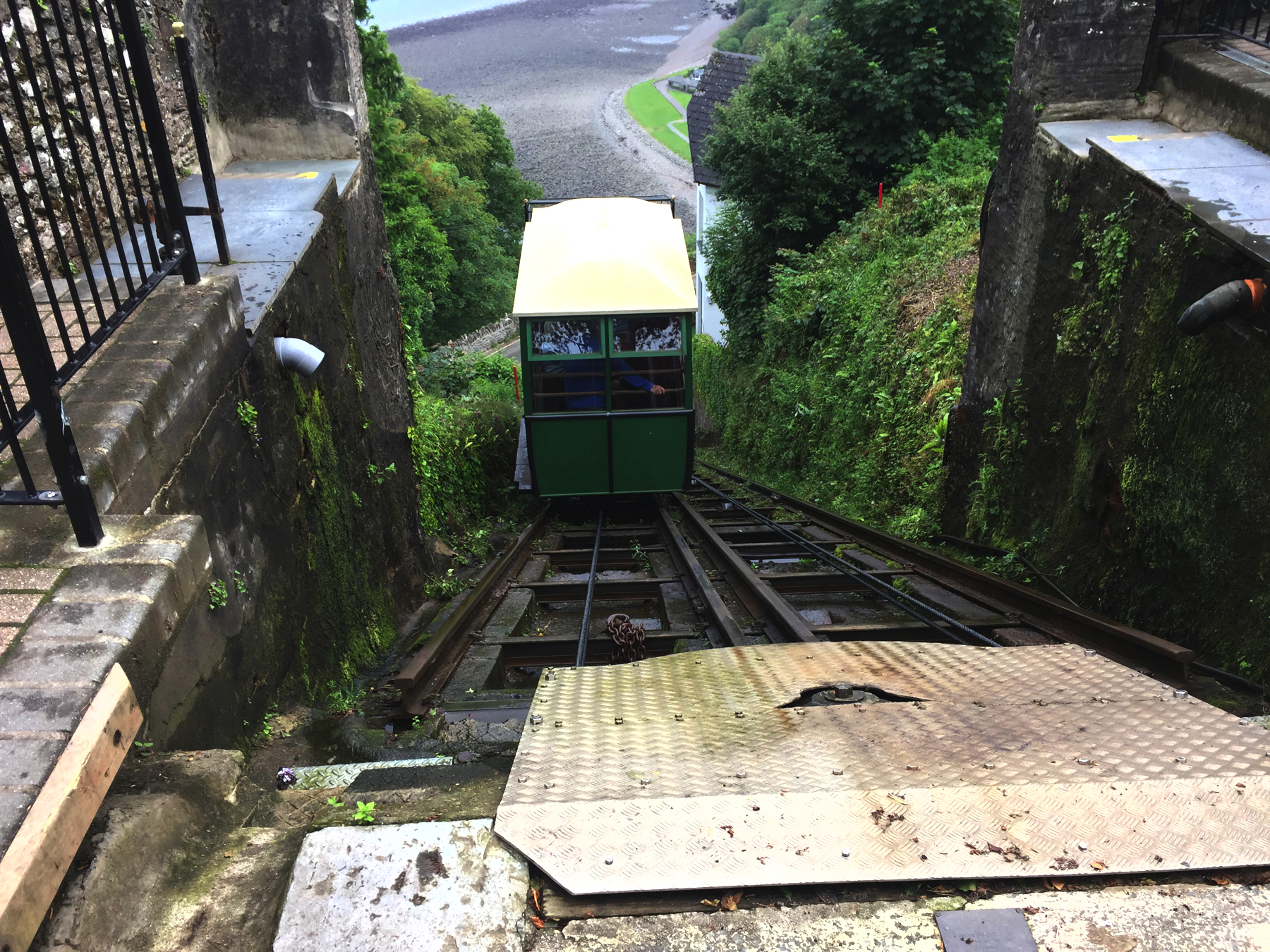
When I had my ticket and was ready to go, after a good group of passengers boarded, I asked to hold back and get to the front of the next car. Granted. We see above here the car on the left side track going down.
Below are scenes from my ride down on the right-hand track, passing under all three bridges and ending at the lower station in Lynmouth.
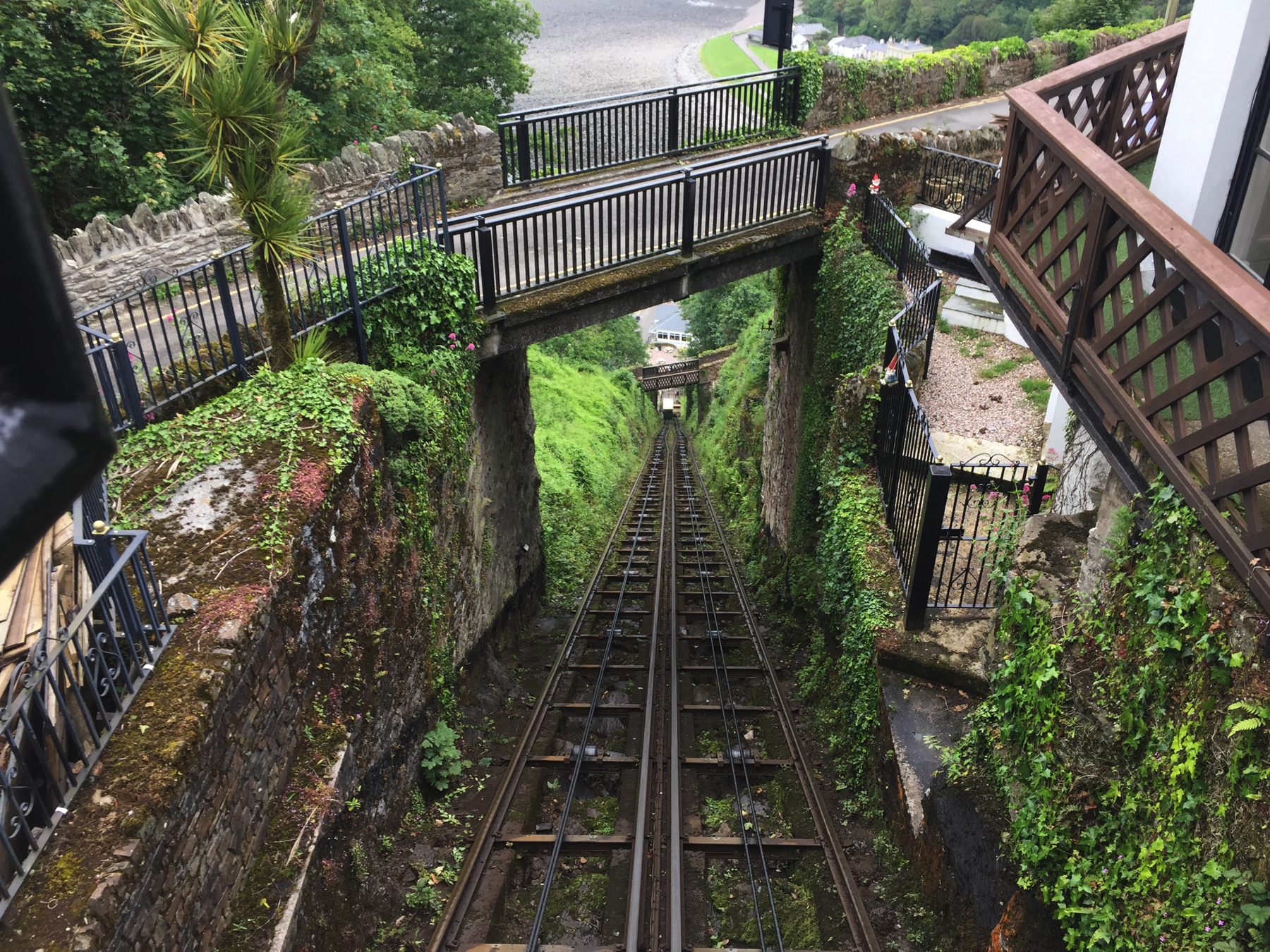
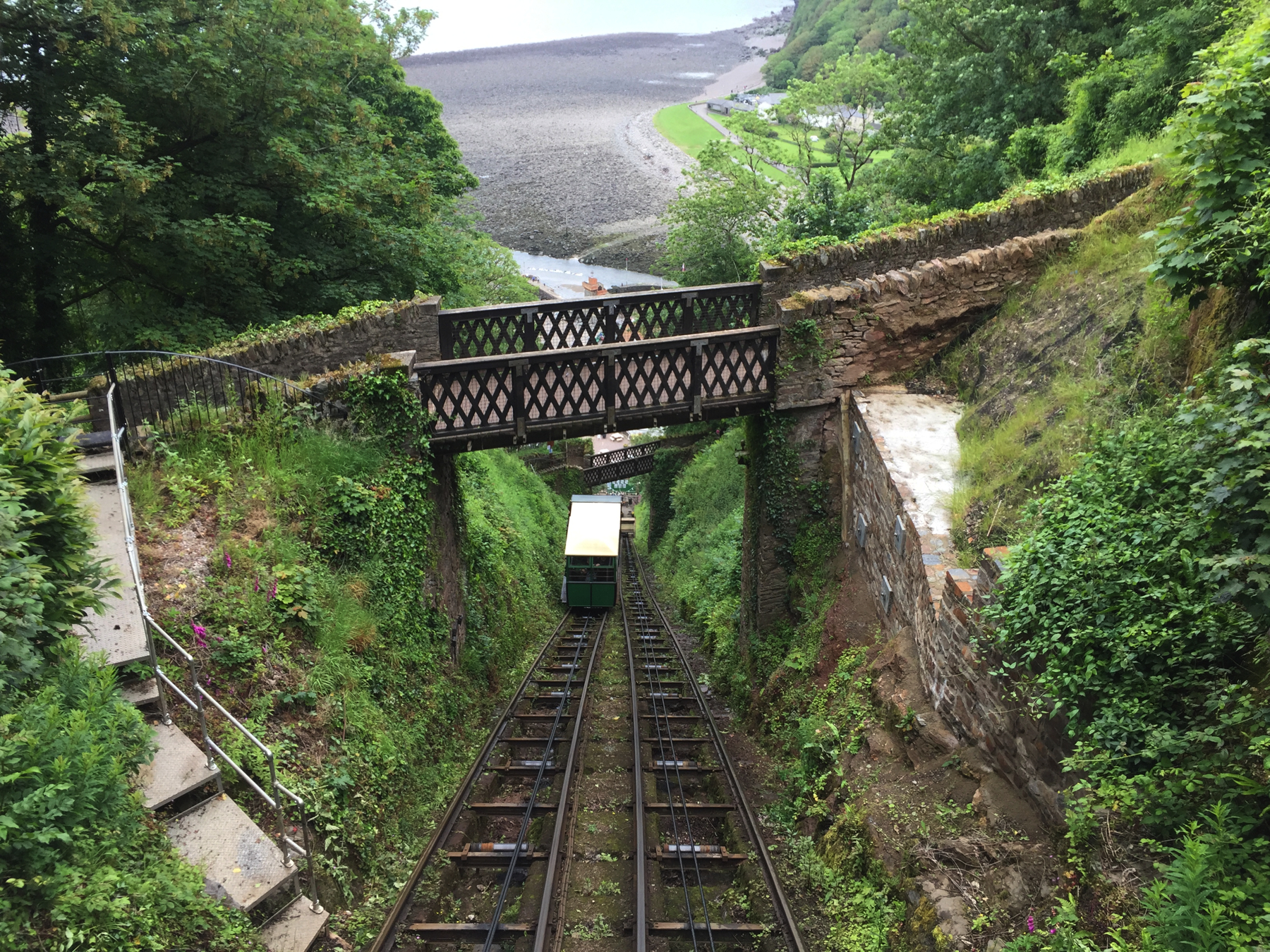
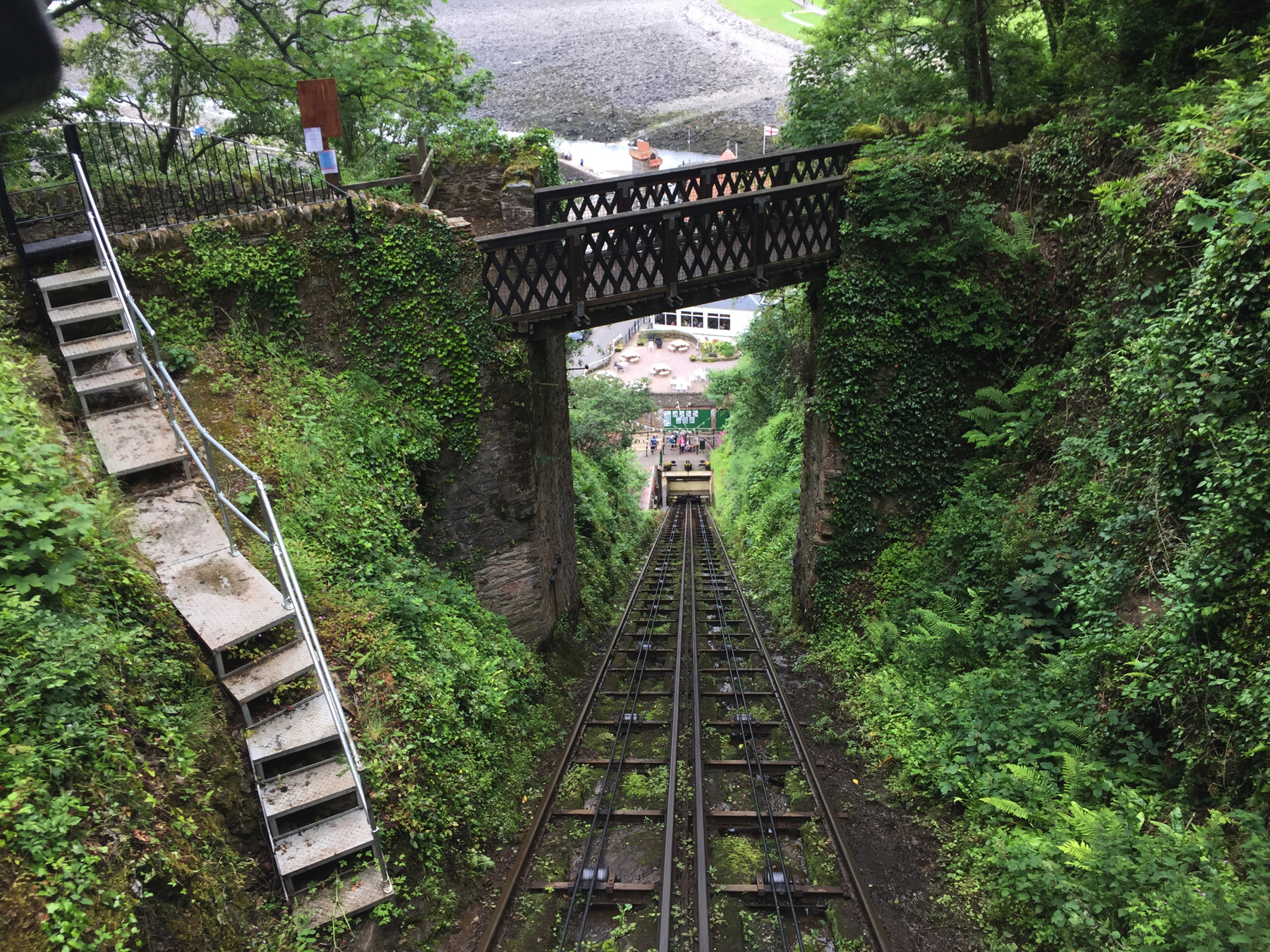
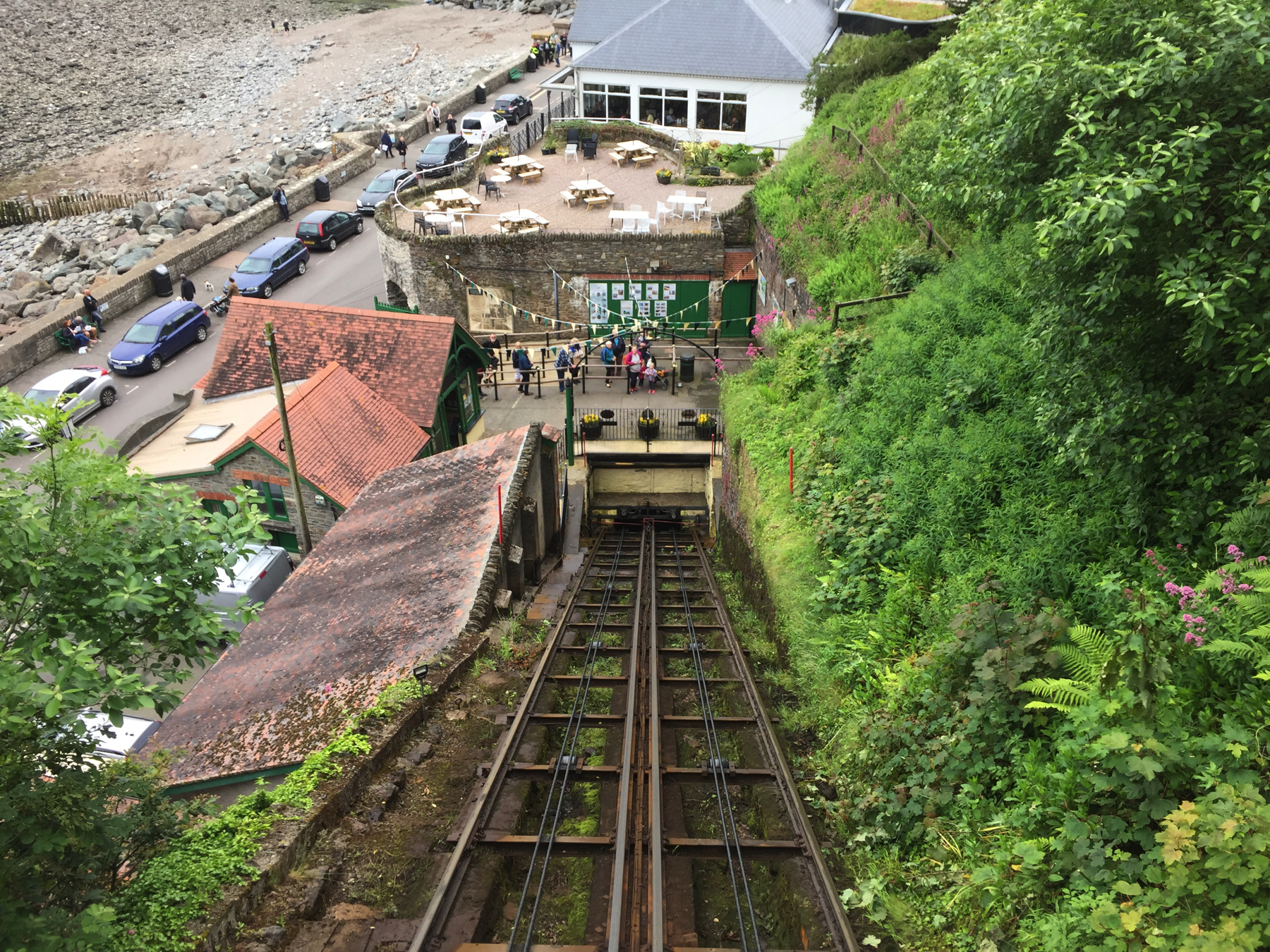
Just after you reach the bottom you can hear the water gurgling out. There is just a narrow road and then the sea wall. I didn't think of going down to the beach to get my feet wet and find where the water flows out. Maybe next time, right?
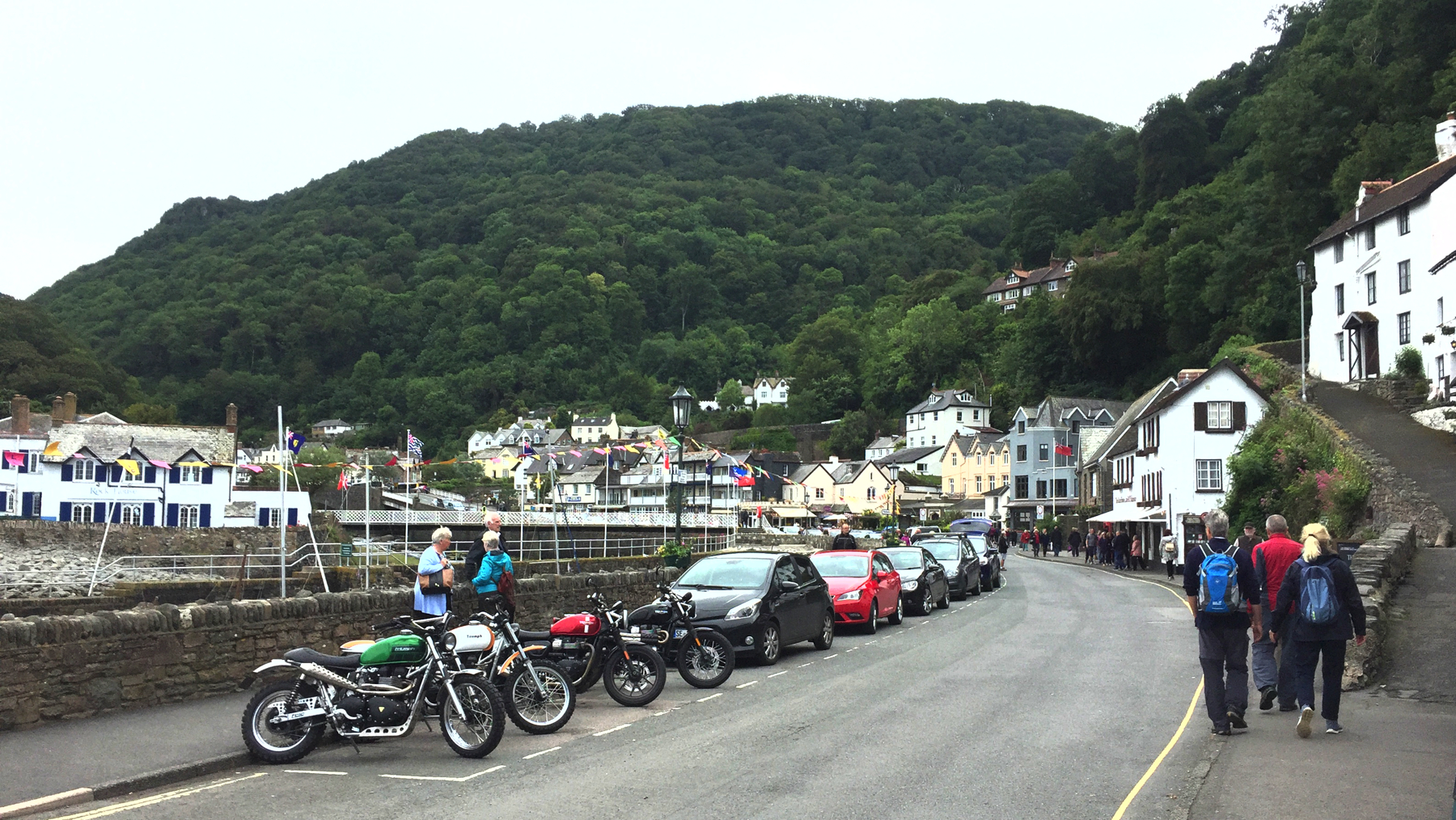
Now I don't want to inspire jealousy, but in my opinion Lynmouth is just not as quaint as Lynton. There is one narrow street that tries its best. But it's all right, Lynmouth. It's certainly a change. Here with the cliff lift behind us we have the River Lyn behind the wall on the left and some more of the town ahead.
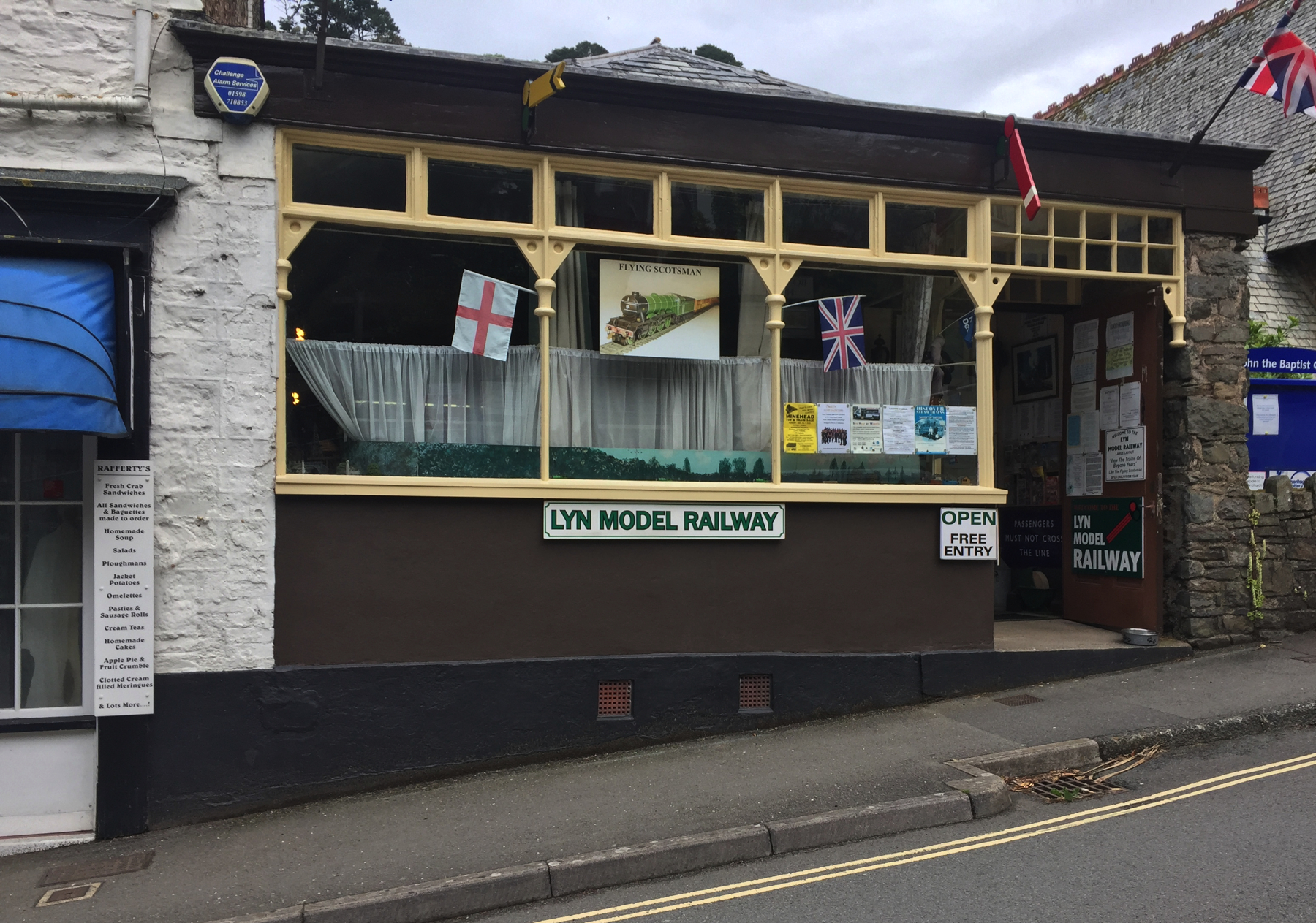
The highlight of Lynmouth, for me at least, is the Lyn Model Railway. The middle-aged man inside told me that his father made the layout. It is offered free to the public. I donated a few pounds. I want to keep this going. It's a terrific model railway. You see only some of it here. Notice the funicular for the quarry!
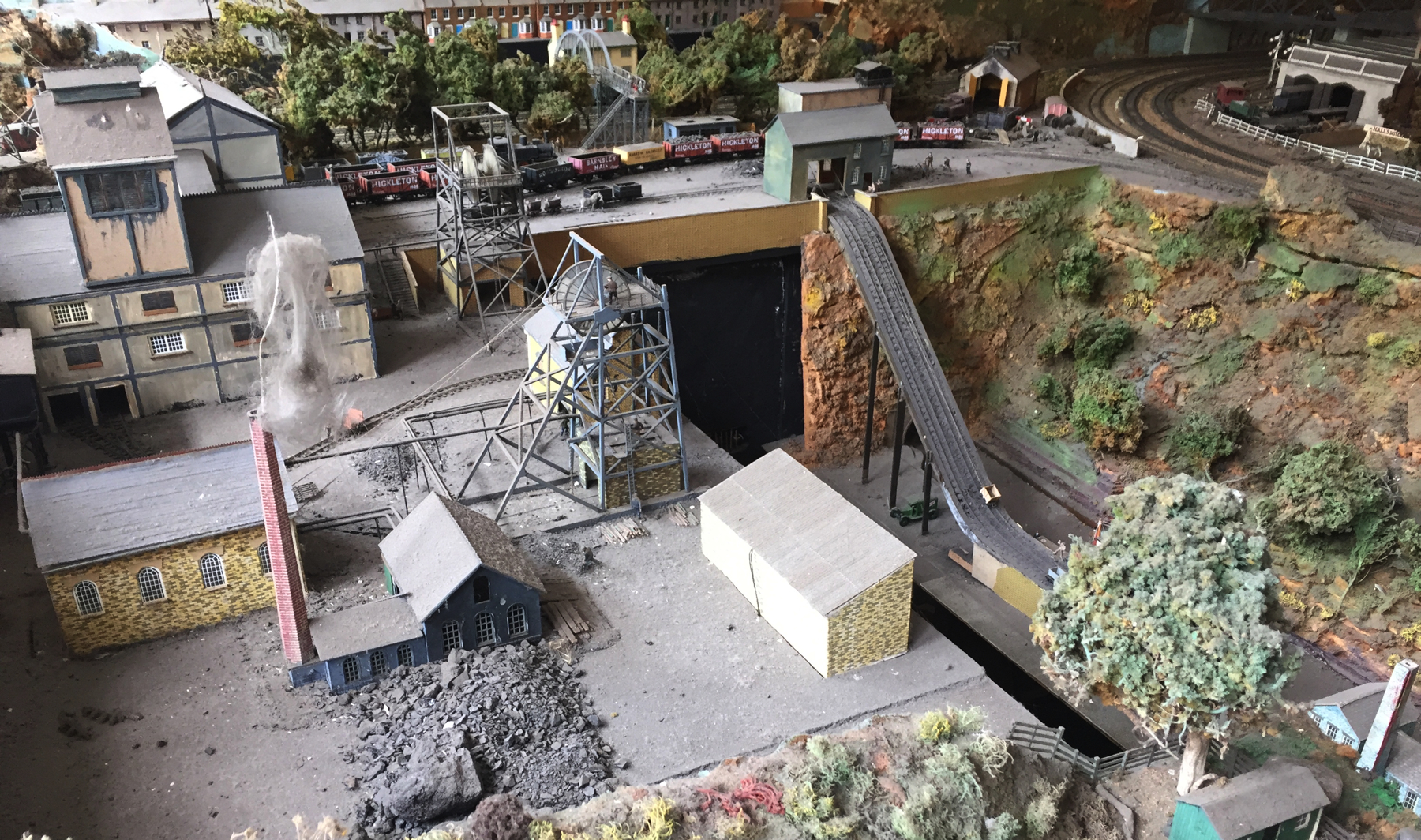
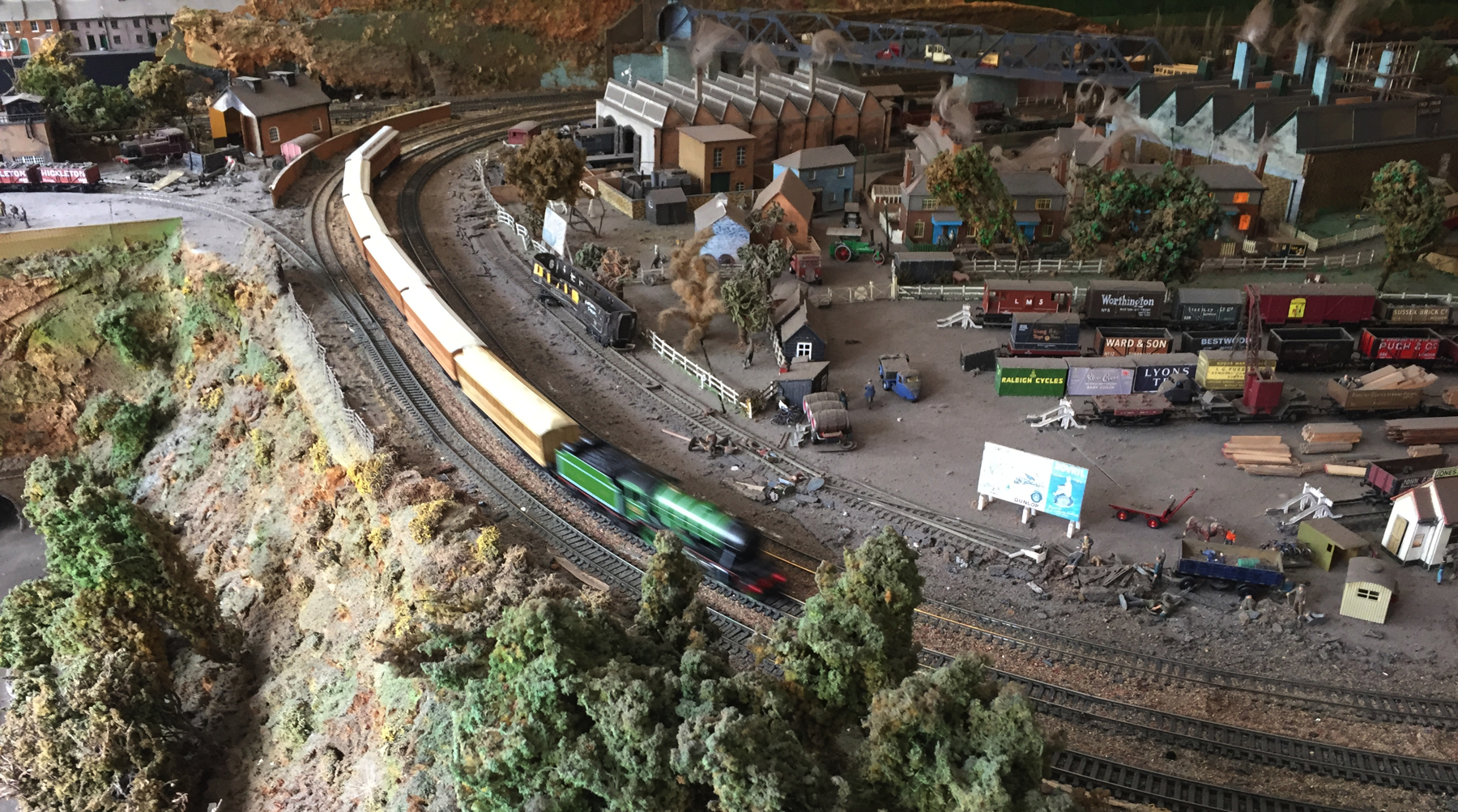
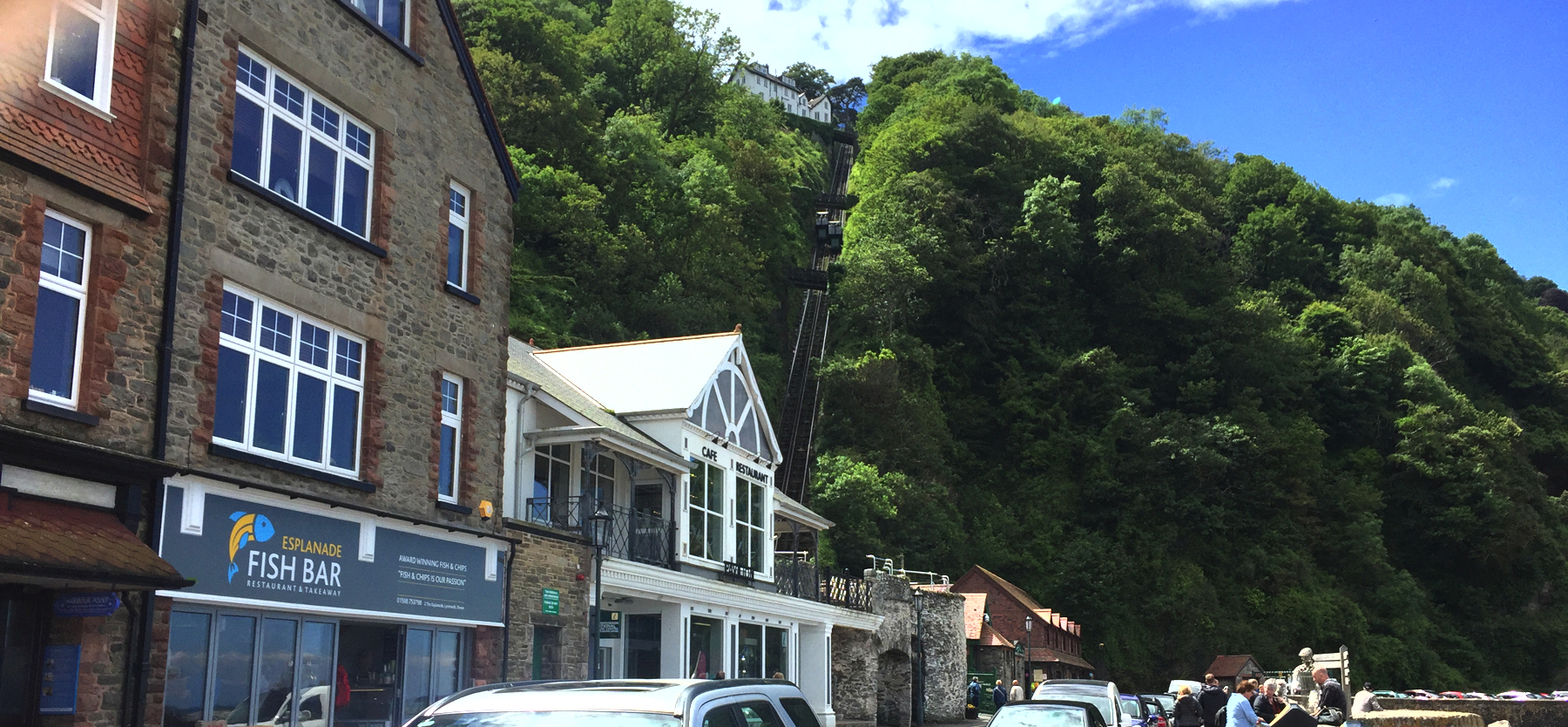
Well, that's about it. Not quite.
I went back up on the cliff railway and made my way to the Lyn and Exmoor Museum, of which I failed to take any pictures. It's a small town museum in an old house, with various mementos of local life, and especially remembrances of the flood of 1952 that destroyed buildings in Lynmouth and cost three dozen lives. I found there also a timetable and photographs of the Barnstaple and Lynton Railway, a narrow gauge railway (1 foot 11½ inches) that once made the journey between its own Barnstaple Town station and a Lynmouth terminal inconveniently sited 200 feet above the village and quite a bit to the south. The train ran through in two hours, compared to 55 minutes by bus today, a bus that goes properly to Lynton itself. After inspecting the museum I went to the Cracker Barrel for a cone of clotted cream vanilla ice cream and found the bus stop.
And then the journey back. Another finely aged driver took us back on the Filers bus. He knew many of the passengers. I felt at home somehow. On the walk to Barnstaple railway station I passed by the Pizza Hut and the Costa in order to make the train, but I knew I needed more food soon.
At Exeter St Davids I found the Starbucks closed for the night at only 7:30, and the Costa outside the station likewise. I was desperate. A small convenience store was the only thing open, and it had a peculiar assortment of food and drink. After a few minutes' consideration my choice was a package of two small chicken tikka samosas, which said on the wrapper that they could be heated up or eaten cold, and a can of Captain Morgan rum with cola, more of the latter than the former I'm sure. This combination I took with me into the train to Paddington. Although the connection at St Davids was closer this time, the train to Paddington called at more stations, so the total journey time from Lynton was about the same as it was going out.
I reached the hotel well exhausted but feeling I'd had a good day. I had planned that tomorrow would be the other very long trip. I slept a sleep.
[note 1] In 2018 we stayed a couple of nights at the Premier Inn right across from Exeter St Davids. There were not always staff at the reception desk, and the elevator that required a room card to go up did not in fact require one, and upstairs the door from the elevator lobby to the hall that required a room card did not even have a lock on it. But that's nothing. We tried the Thyme Restaurant in the hotel. I should have known something was up when we were asked whether we had a reservation and I could see that almost no one was there. I soon realized that we might have taken the improv troupe by surprise. They did well though. There was the old man who asked the waiter his name, and was told John, and said oh yes, like John the Baptist, I can remember that. Later on he asked him, what is our name, John? The other old man kept relating his experience at the Premier Inn at Ayr, spelled A, Y, R, it's in Scotland, not the one near the airport, I don't fancy an airport, the other one. The waiter asked, the one near the racetrack, and the man said, was it near a racetrack, I don't remember that, it was in Ayr, A, Y, R. Then there was the nice young woman who could not speak and was trying to ask the waiter for something, unsuccessfully, until finally the other waiter said that she likes toast with her dinner, and when she was finally served the toast she gave a thumbs up and a beautiful smile. During all this the two waiters kept asking the third one for The Key that did some obscure function at the register. What topped it off was the late entrance of the couple and child with suitcases who explained they were on their way from Paris to somewhere I didn't catch and had decided to stop here for their first meal since breakfast. As if Exeter would be on the way from France to anywhere. They had come through the tunnel, the mother said, and the waiter asked, oh from Bristol? We finished eating and left. I don't know what else was coming if we had stayed. I hope all this is not Spoilers. May I suggest the pub up the hill.